


FEEDING THE GUT MICROBIOME
Important for equine health, performance & longevity


FROM SUNLAND TO SAUDI ARABIA
Todd Fincher’s journey to Saudi Cup victory

BLOODSTOCK BRIEFING
Examining the sire lines that are no longer popular







Important for equine health, performance & longevity


Todd Fincher’s journey to Saudi Cup victory

Examining the sire lines that are no longer popular



In our Triple Crown issue, we celebrate the journey that has taken Todd Fincher from Sunland Park to Saudi Arabia with Senor Buscador this spring and learn of his desire to branch out and expand his stable outside of his base in New Mexico.
We also profile Danny Gargan who goes into the Triple Crown season with two exciting sons of Good Magic. Good Magic has proven to be a lucky sire for Gargan. He has now trained three of his colts and all three have earned Black-Type.
Being our Triple Crown issue, we profile three sets of owners who are going into the Triple Crown season with high hopes for their colts. Eric and Sharon Waller with their homebred, Stronghold, the Albaugh Family Stable with Catching Freedom and Emily Bushnell and Ric Waldman with Resilience.
Sadly, Emily’s father - Martin Wygod - died just days after Resilience’s success in the Wood Memorial and should Resilience win a Triple Crown race, there would be no more fitting tribute to the legacy of one of North America’s finest breeders who was involved with the breeding of 124 stakes winners of which 32 were Graded stakes winners and 15 of those were Grade 1 winners.
We also examine how the ‘Road to the Kentucky Derby’ has changed the path to the Triple Crown. This year’s ‘Run for the Roses’ has benefited from a substantial purse hike to $5m and this year’s running will be the twelfth Derby since the point system was introduced back in 2013.
As Jennifer Kelly tells us; the number of horses going from Louisville to Baltimore has remained steady, with an average of four horses making the trip, until 2023, when only Kentucky Derby winner Mage tried the Preakness Stakes. So far, the decreasing number of horses returning for the Preakness may be attributed more to the trend of spacing races out rather than the effects of pursuing points.
But will the number of Derby horses going to the Preakness change this year? Don’t forget that this year 1/ST Racing have doubled the purse for the Preakness (to $2m) and are launching an innovative bonus which will see the winner of the Preakness be inline for a potential $5m bonus should they go onto win the California Crown at Santa Anita in September ($1m) and the 2025 Pegasus World Cup ($3m) next January at Gulfstream Park.
Initiatives like this are good for the sport and the management team at 1/ST are never short of ideas when it comes to creating brand identity for key races run under their umbrella.
But as Alan Balch tells us in his opinion piece, there is a sense of animosity between stakeholders in the Californian industry and the management of Santa Anita about the future direction of racing in Southern California.
In our summer issue (published at the end of July) we will be delving deeper into what the future landscape for racing and breeding will look like in California.
But change will only happen if all those involved in the industry can actually agree on a plan for change. Stagnation won’t get anyone anywhere and as an outsider looking in, the first thing that needs to be addressed is the lack of additional revenue streams which are, in my opinion, the root cause as to why Californian racing sees itself where it is now.
Before I wish you all the best of luck for wherever racing takes you over the next few months, you will notice that we have included our first ever annual North American ‘Feed & Nutrition Guide’ – which outlines different supplements to support your horses, with this issue of the magazine.
A digital version of the guide can be accessed via the QR code below or online at trainermagazine.com
So, until we publish our next issue for the end of July, good luck wherever your racing takes you until then!


Editorial Director/Publisher & Advertising Sales
Giles Anderson (859) 242-5025
Sub-Editors
Lauren Godfray & Nico Jeeves
Advert Production, Circulation/Website
Lauren Godfray (1 888-218-4430)
Cover Photograph
Eclipse Sportswire
Trainer Magazine is published by Anderson & Co Publishing Ltd.
Tel: 1 888-218-4430 Fax: 1 888-218-4206
info@trainermagazine.com
www.trainermagazine.com
North America
PO Box 13248, Lexington, KY 40583-3248
United Kingdom
Ground Floor Office, 72 Medstead Road, Beech, Hampshire, GU34 4AE

Trainer Magazine is the official magazine of the California Thoroughbred Trainers. It is distributed to all ‘Trainer’ members of the Thoroughbred Horsemen’s Association and all members of the Consignors and Commercial Breeders Association, the Maryland Horse Breeders Association, the New Mexico Horse Breeders Association, the Pennsylvania Horse Breeders Association, the Alberta Thoroughbred Owners & Breeders Association and the Virginia Thoroughbred Association.
Alan F. Balch was hired as the executive director of the California Thoroughbred Trainers in April 2010. His professional career in racing began at Santa Anita in 1971, where he advanced to the position of senior vice president of marketing and assistant general manager, and was in charge of the Olympic Games Equestrian Events in Los Angeles in 1984. He retired in the early 90s to become volunteer president of the National Equestrian Federation of the USA, as well as of the National Horse Show of Madison Square Garden. He remains president of USA Equestrian Trust, Inc.
Jackie Bellamy-Zions has been Equine Guelph’s communications manager for the past 10 years and has over 30 years experience in the horse industry in the capacity of coach, trainer, stable manager, competitor, judge and journalist.
Cassie Fraser, a native Vermonter, is the content writer for Etalon Equine Genetics. Her background in veterinary medicine, horse training and marketing helps her bridge the gap between equestrians and genetic testing.
Bill Heller is an Eclipse Award-winning author who published his 27th book, Fred Hooper – The Extraordinary Life of a Thoroughbred Legend. His other biographies include Hall of Fame jockeys Ron Turcotte, Randy Romero and José Santos. Bill and his wife Marianne live near Gulfstream Park.
Jennifer S. Kelly is an author and freelance turf writer. Her first two books, Sir Barton and the Making of the Triple Crown and The Foxes of Belair: Gallant Fox, Omaha, and the Quest for the Triple Crown, chronicle the lives and careers of the first three American Triple Crown winners. She also contributes to The Racing Biz, America’s Best Racing, and TwinSpires Edge. Jennifer’s work focuses on both the history of horse racing as well as current events, drawing on her deep knowledge and experience to share stories of the names and faces of this great sport.
Dr. Richard McCormick M.V.B, Dip.Eq.St, M.R.C.V.S is an EU (Ireland/UK) and USA (Kentucky) licensed equine Veterinarian with a passion for nutrition and peak performance developed over eight decades. Richard’s nutrition focused company Belmont Equine Products has developed a complete and proven feeding program for equines using an oat based diet.
Holly Robilliard is a published author and scientist, with a passion for equine health. For the past two years she has worked at Etalon Equine Genetics, helping to revolutionize the way we breed and train horses.
Jordin Rosser is the current IT Coordinator at Ocala Breeders’ Sales. With a newfound love of racehorses, she is ready to mix her passions of IT with the horse racing world and share all of the findings.
Ken Snyder is a current turf writer for Gallop magazine, and a turf/travel-culture writer for Kentucky Monthly magazine. His work has appeared, as well, in other publications, including The Blood-Horse He and his wife, Cassie, reside in Kuttawa, Kentucky.



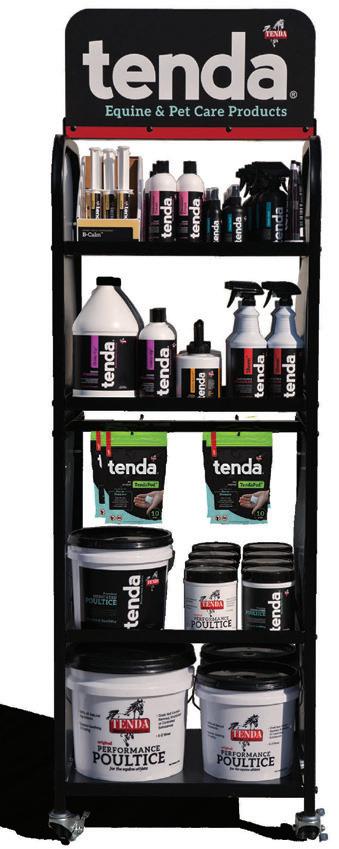

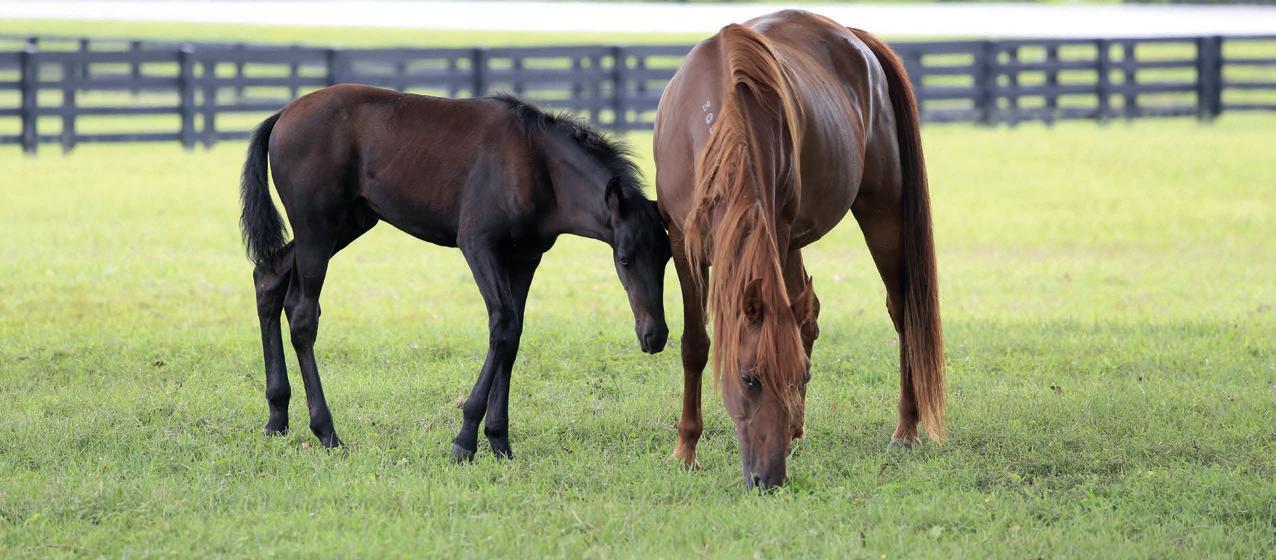

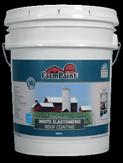






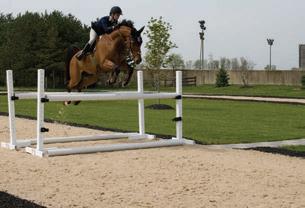




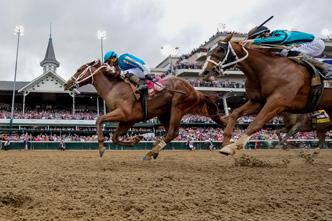


08 Danny Gargan
Bill Heller profiles how Gargan is knocking on the door of the 2024 Kentucky Derby double handed.
22 Trust your gut
Richard McCormick talks of the importance of feeding the gut microbiome for health, performance & longevity.
32 From Sunland to Saudi
Ken Snyder shares Todd Fincher’s journey with Senor Buscador from Sunland Park to Saudi Arabia.
40 Thoroughbred genetic research
Holly Robilliard and Cassie Fraser discuss the principles of genetic research and its use amd implementation within the thoroughbred racing world.
46 Bloodstock Briefing
Jordin Rosser examines the sire lines which are no longer popular and asks what has caused their demise?
52 Road to the Kentucky Derby
Jennifer Kelly asks, does the need to win points to get into the KY Derby starting gate, mean racing potential classic winners more than in the past. How does that impact their chances over the five weeks?
60 Predicting cartilage quality
Jackie Zions interviews Dr. Adele Changoor and Dr. Judith Koenig on the new research available on the use of Electroarthrography to predict cartilage quality.
64 Graded Stakes winning owners
Bill Heller features winners owners of Stronghold – Eric and Sharon Waller, Catching Freedom – Dennis Albaugh and the Albaugh Family Stable and Resilience – Emily Bushnell and Ric Waldman.
72 Data driven trainers
Jennifer Kelly looks at the growing use of digital training tools and how HISA has changed trainers workflow.
06 View from the CTT
Alan Balch – Fiefdoms Redux?
78 #Soundbites
Bill Heller asks “Why are the average number of starts and field size declining annually?

Visit trainermagazine.com to download our current digital editions and access back issues of both European and North American Trainer.




I’m reminded of racing’s counterproductive fiefdoms by a 2008 writing in these pages of the late Arnold Kirkpatrick, my much-revered colleague and friend. Back then, it seemed to him, there were way too many fiefs in the way of industry-wide accomplishments.
To Arthur Hancock’s suggestion that our problems were caused by a lack of leadership, Arnold was “unalterably convinced that our problem is not a lack of leadership but too much leadership.” He counted 183 separate organizations in Thoroughbred racing alone, each with their own agendas and jealousies. “With 183 rudders all pointed in different directions, we have two possible outcomes – at best, we’ll be dead in the water; at worst, we’ll be breaking apart on the rocks.”
In 2024, can it be said, without irony, that this is the best of times, and the worst of times?
In North America, and California in particular, an historic sport and industry contraction is well underway, by every possible indicator – led by the declining foal crop. One might think there has been a corresponding contraction in the list of racing’s organizations; somehow, I doubt that’s true. Nevertheless, in the “Golden State,” once a perennial leader of American racing, we have lost a critical mass of tracks since 2008: Bay Meadows, Hollywood Park, fair racing at Vallejo, San Mateo, Stockton, Pomona, and Golden Gate Fields this year.
Is it simply a coincidence that this all happened while one racing operator – the Stronach Group – increasingly dominated and controlled the sport in California, as no track owner ever before was permitted to do?
Arnold’s word “fiefdom” ... comes back to mind, but now from a different perspective. In European feudal times, as we learned in school, the fief was a landed estate given by a lord to a vassal in return for the vassal’s service to the lord. There are a great many California owners, trainers, breeders, jockeys, vendors, fans, and even regulators, who have been wondering how the vassals ever turned the tables.
In a Los Angeles Times interview published on April 5, Aidan Butler, the CEO of 1/ST Racing and Gaming, the Stronach operator, used the term “imbeciles” to describe those who would question the company’s intentions, and perhaps its motives, in sending what was widely perceived as a blatantly threatening letter to the California Horse Racing Board.
Instead, he termed the letter “transparent.” And then stated, “if nothing else, people have been forewarned.” Seconds before, he had claimed that the amount of money Stronach had invested in Santa Anita proved its good intentions. This is the same executive who months earlier had suddenly announced, giving stakeholders notice of only hours, that Golden Gate Fields would be closed within weeks, before changing his mind under pressure from the rest of the industry.
Confused?
Stronach’s track management may be described many ways; truthfully “transparent” is certainly not one of them, despite constant assertions to the contrary. As a private family company, even in a regulated industry, its leaders can claim whatever they want with impunity. After all, the exceptionally valuable real estate on which most (all?) of their track holdings reside appears to make them immune from audit or inspection: they rarely, if ever, are reluctant to tell their racing fraternity vassals that it’s their way or no way. The damage resulting from that attitude is staggering.
Edward J. DeBartolo, Sr., was a predecessor billionaire owner of multiple American tracks. Perhaps, however, because of his ownership of great and successful team sports franchises, among other interests such as construction, retail, and shopping center development, not to mention education and philanthropy, he knew what he didn’t know. He realized he always needed teammates. He delighted in saying to his fellow track owners that managing race tracks was by far the most difficult of all his enterprises, due
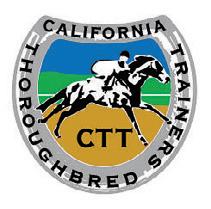
to the elaborate interdependent structure of racing, and its nearly infinite number of critical component interests, each with different expertise. More complicated than any of his other pursuits, he said! To succeed in racing challenged him to learn, and his success resided in hiring, consulting with, and relying on people who knew more than he did. As it did in all his businesses.
Even to the most oblivious, it can’t have been hidden to the Stronach leadership that entering the heavily-regulated California racing market in the late 1990s would present serious challenges, at least as enormous as the opportunities. Acquiring the two glorious racing properties of Santa Anita and Golden Gate (with a relatively short leasehold at a third, Bay Meadows) had to have been exciting. To someone with the DeBartolo outlook on interdependent management, rather than the inverse, it could have been invigorating and boundlessly successful.
That the opposite has resulted is an enormous tragedy for the sport worldwide, not just in California. After all, the State of California’s economy (as measured by its own Gross State Product) is among the top five in the world, outranking even the United Kingdom’s. How could this happen?
Had Stronach leadership begun, at the outset, consulting and cooperating in good faith with its California partners (including regulators, legislators, and local communities, not to mention fellow racing organizations, the owners, trainers, breeders, and other tracks), learning from them as teammates rather than dictating to them, California racing would look far different now than it does. Its imperious and constantly changing management leadership compounded perennial problems and threats, not to mention complicating the industry’s politics and standing in California sports. Obvious failures to understand California markets and invest in sophisticated communications and marketing also have been apparent, despite continual assertions to the contrary.
Is there still hope for California racing? Yes ... but if and only if honest humility suddenly appears from Stronach leaders, and immediate, sincere engagement occurs with all the rest of the interdependent entities upon whose lives and success the racing industry depends.








Hall of Fame trainer Nick Zito didn’t have a horse in either the Grade 1 Ashland Stakes at Keeneland April 5th nor the Grade 1 Blue Grass Stakes the following day. But he hoped for a personal daily double of those races with two of his protégés, Jorge Abreu and Danny Gargan, saddling a top contender in each race - Abreu with Jody’s Pride in the Ashland and Danny Gargan with Dornoch in the Blue Grass.
Zito didn’t get what he wanted. Jody’s Pride ran out of gas in the Ashland and is getting a freshening before resuming her three-year-old campaign later this summer. Dornoch finished fourth in the Blue Grass and is now all systems go for a run in the Kentucky Derby.
Come the first Saturday in May, Danny Gargan will remember his first Kentucky Derby runner, Tax, who he claimed for $50,000 in his second career start in a maiden claimer at Keeneland on
October 21st, 2018. Tax took Gargan to the 2019 Kentucky Derby, when he finished 15th, beaten 15 lengths at odds of 35-1.
Tax went on to win the Grade 2 Jim Dandy Stakes at Saratoga and the Grade 3 Harlan’s Holiday Stakes at Gulfstream Park and in the process became Gargan’s highest-earning horse with $1,102,160. “He’s my favorite,” Gargan said.
Gargan did his homework to nab Tax, a son of Arch out of the Giant’s Causeway mare Toll. “I watched his video in his first race,” Gargan said. “He’s a really well-bred horse. He looked beautiful in the video. He sprinted that day. I was in New York, looking around for horses. He popped up in the entry box at Keeneland. I flew from New York to Kentucky to claim him.”
When he did, he called two of his owners, Randy Hill of R.A. Hill Stable and Dean Reeves of Reeves Thoroughbreds. “He called me up and asked me if I wanted in on Tax,” Hill said. “I said yes. Obviously, that worked out well. Danny’s one of my favorite guys, Danny’s a very good trainer. He’s finally gotten a chance to work with some good horses. He’s a terrific guy, he deserves this.”
Reeves said, “We had a lot of fun with that horse. It was a great run. Winning at Saratoga especially a big race up there.”
Gargan loved Tax: “He was a wonderful horse to be around, big and beautiful, just a kind soul in the barn. You loved seeing him there every day. He had a long career. He stepped into a grate and got his ankle caught. He missed more than a year.”
Tax came back off a 16 ½ month layoff to win a $100,000 stakes at Delaware on July 9th 2022, an outstanding feat by Gargan. “He was a pretty cool horse,” Gargan said.
Gargan has now trained three sons of Good Magic and all are now stakes horses. First up was Dubyuhnell who in 2022 Gargan thought might take him back to the 2023 Kentucky Derby after he captured the Grade 2 Remsen Stakes in his final start as a two-year-old. Instead, he finished 8th in the Grade 3 Sam F. Davis and 11th in the Grade 1 Florida Derby.


Now in 2024, Gargan has two sons of Good Magic in the Kentucky Derby. Dornoch, who finished fourth in the Grade 1 Blue Grass and Society Man, who finished second in the Grade 2 Wood Memorial at odds of 106-1.
Dornoch looks as talented as his full brother, Mage, who won the 2023 Run for the Roses. “They look opposite,” Gargan said.
“My horse is a real big bay. Mage is a medium chestnut. They don’t look the same, but they both have big hearts. You can’t breed that.”
Dornoch, was bred by Grandview Equine and sold for $325,000, $90,000 more than his full brother Mage, at the 2022 Keeneland September Yearling Sale.
Last November Mage and Dornoch’s dam, Puca, went through the ring at Keeneland and was sold privately for $2.9m. This year, on April 4th, Puca produced her third colt by Good Magic who like his esteemed brothers all share an April birth date.
Dornoch’s name is intriguing, referring to the Royal Dornoch Golf Club in the Scottish Highlands where golf has been played for more than four centuries.
Born one year and four days after Mage was foaled, Dornoch spent his early days at historic Runnymede Farm in Paris, Kentucky.

For his early education, Dornoch was sent to Raul Reyes at King Equine in Ocala, Florida. Reyes detected that Dornoch wasn’t moving comfortably in his behind and discovered that one of Dornoch’s testicles hadn’t descended. The testacle was removed, and Dornoch showed vast improvement immediately.
Reyes called it a 360° turnaround in a story in Blood-Horse Gargan thinks Dornoch will offer him a different experience if he makes it into the Derby starting gate.
“Tax got us there. We were lucky enough to do the walk-over. This is different. This horse can win it. I’m happy to be a part of it. He reminds me of Louis Quatorze (the 1996 Preakness Stakes winner trained by Gargan’s former boss, Hall of Fame trainer Nick Zito). I’m hoping Dornoch can win a Triple Crown race. I’m preparing him the same way Nick did with Louis. Just keep moving forward. In horse racing, you have to hope you have a great day. In the past, we were just happy to be there. Now we have a horse that could win it.”
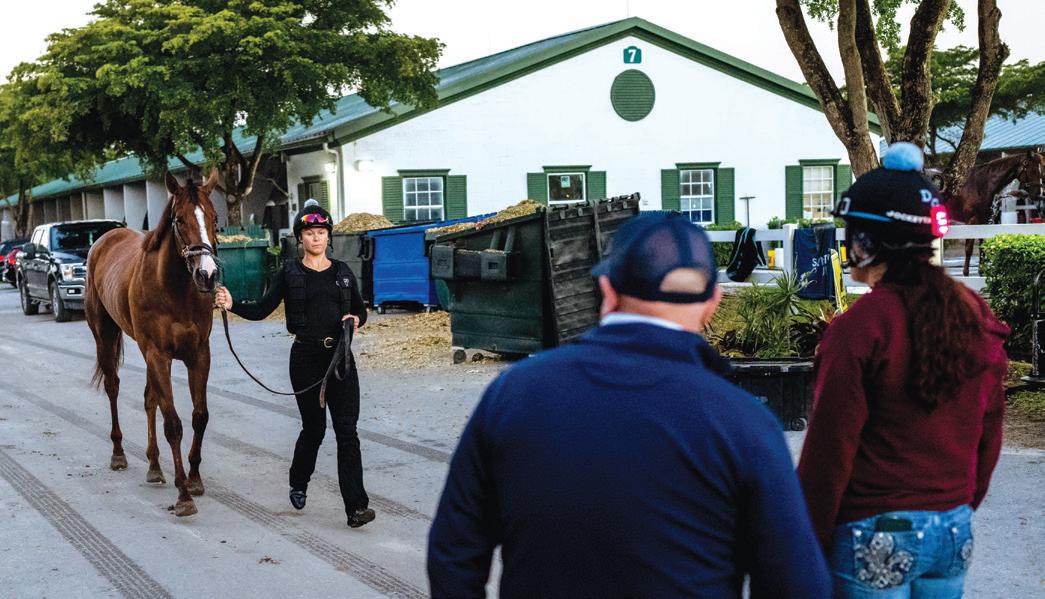
Zito, has been a fan of his protégé for a long time: “Danny was probably the best one I ever got along with. He read my mind. The guy actually read my mind, which I loved. He wants to win so bad. He communicates with horses so well. He said Dornoch resembles Louis. It shows his remembrance of great horses. That’s what I admire about Danny Gargan. Danny’s not taking a back seat to anybody at the Derby. He’ll have his horse ready to run.”
If Dornoch or Society Man win the Kentucky Derby, it will come 51 years after Gargan’s father, also named Danny, rode Bag of Tunes to win the 1973 Kentucky Oaks.
Unfortunately, Gargan, a native of Louisville, was just four when his father died. “I was so young, I don’t remember that,” Gargan said. “I grew up on the backside of Churchill Downs. I loved it from the start. It’s just something in your DNA.”
Asked how he got onto the Churchill Downs backstretch, Gargan said, “It was 30 years ago. Back then, they let everybody in.”
He worked for Nick Zito off-and-on for several years, eventually becoming his assistant. “Me and Nick are real good friends to this day,” Gargan said.
Gargan, though, came to a conclusion: “It takes a lot of money to be a horse trainer.”
So he switched careers, becoming a jockey agent. “I did it for a few years,” he said. His clients included Pat Valenzuela, Brian Hernandez Jr. and Jesús Castañón.
He called his jockey agent days “a lot of fun,” but he eventually became bored with it. He hooked up with owner Merrill Scherer on a few horses and, after two real good meets at Saratoga in 2011 and 2012, Gargan decided to begin training on his own. He credits P.J. Campo, the racing secretary and then vice- president for racing of the New York Racing Association, for pushing him in that direction.



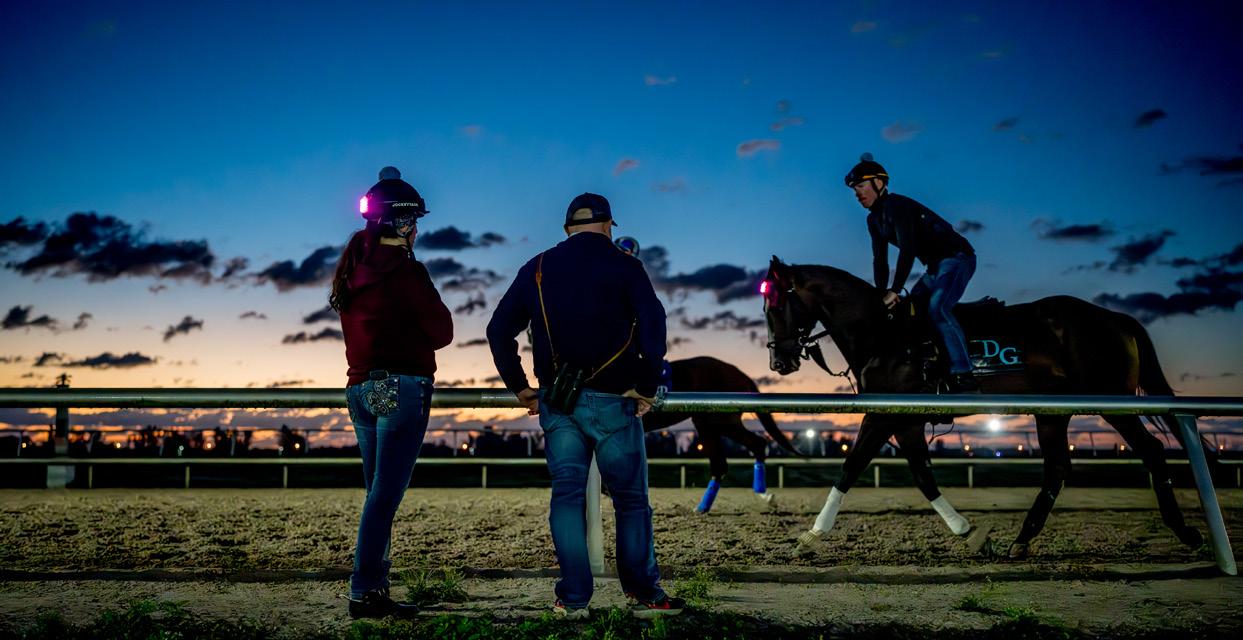
Gargan began a modest-sized stable in 2013, broke the $1 million mark in earnings in 2015 and has had at least $1.8 million in earnings every year since. “I race at Gulfstream Park and New York,” he said. “I don’t train a ton of horses, eight in New York and 22 in Florida. When you get so few young horses, it’s a blessing to have one,” he said. “It’s not every year. I’ve been lucky to have some nice horses in the past, and you have to be just thankful.”
Tax was not his only great claim.
On May 15th , 2017, Gargan claimed Divine Miss Grey for $16,000 for R.A. Hill and Corms Racing Stable off a three-quarter length victory as the 1-2 favorite.
Divine Miss Grey turned into a star for her new connections, finishing second in the 2018 Grade 1 Beldame at Belmont Park and capturing the Grade 2 Chilukki Stakes at Churchill Downs. She finished her career 12-for-26 with six seconds, one third and earnings of $934,172. “You get lucky sometimes,” Gargan said. “The good thing about what she did for me, was she brought me Dean Reeves and Randy Hill. They are the ones who probably brought me to train Dornoch. They wanted me to train younger horses. Without those two supporting me, I might have never made it to this point.”
Hill is one of many partners on Dornoch. Reeves is not.
When asked about his success, Gargan said, “I’m pretty lucky in that I trained for some good people, like Dean Reeves and Randy Hill. They want the horse put first. Always put the horse first. I’m blessed for having them. I don’t have to work the horse or race the horse. When you have owners that understand that stopping and doing the right thing for the horse is the most important thing, that’s great. That’s what’s changed for me the last four, five years is to be able to always put the horse first.”
He knows what he’s up against: “This game can be tough. You try to keep them happy, keep them healthy and keep them racing. It’s something we’ve always believed. With the young horse, it’s a tremendous factor. You watch other trainers and learn.


The September Sale is world-renowned for its unmatched atmosphere and abundance of quality—characteristics that set it apart from every other sale.
$121,615,000 GROSS SALES
$510,987 AVERAGE
$400,000 MEDIAN
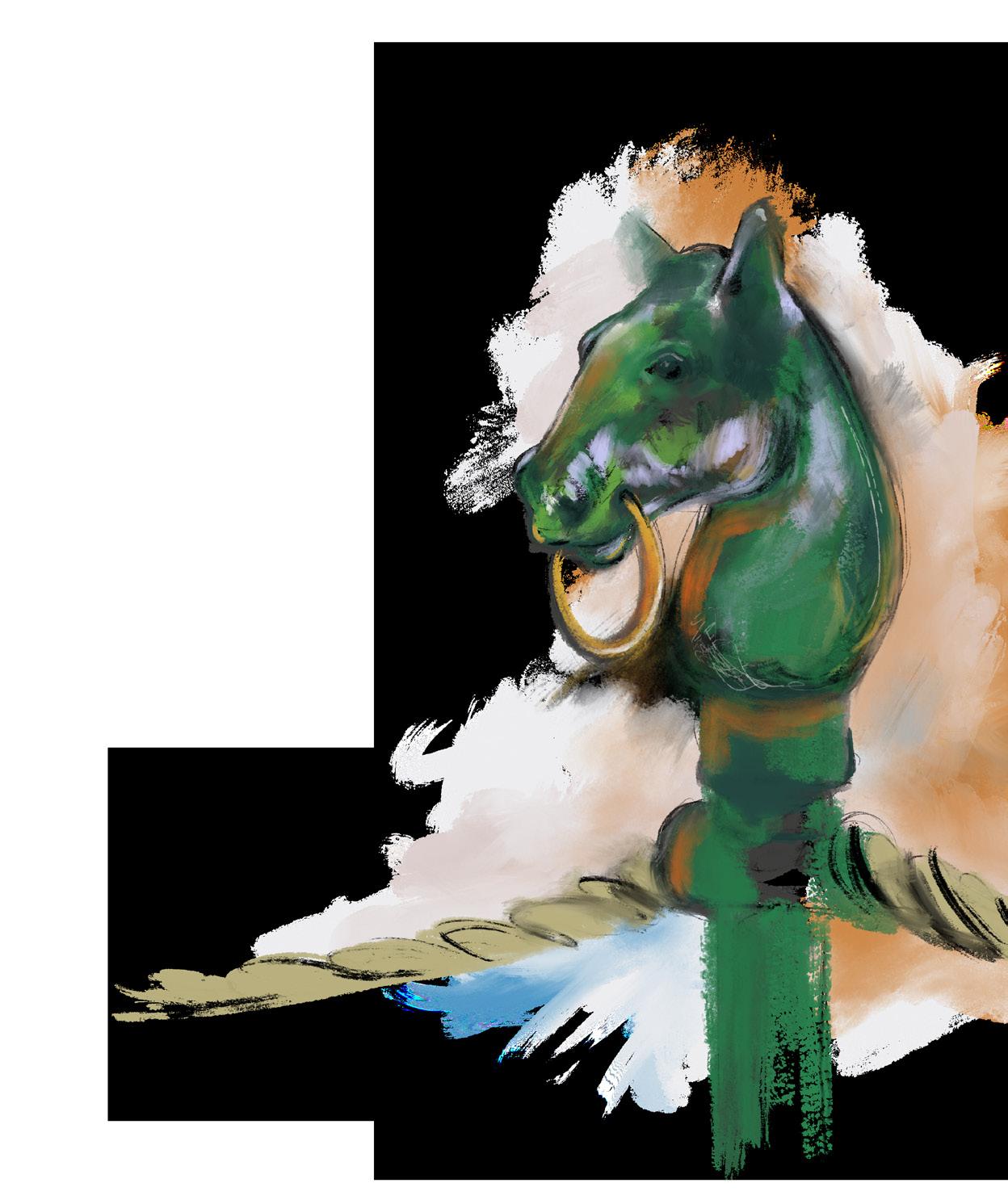


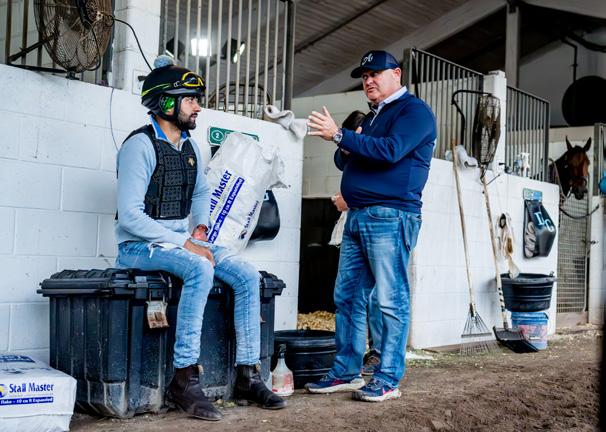
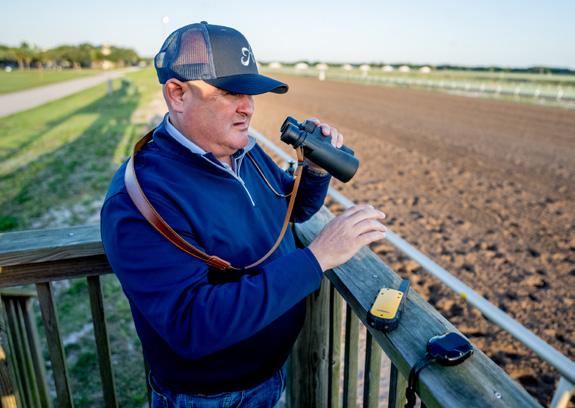
Nick was a
Bill Mott does that, too. They don’t have to win first time out. They’re going to get better with racing. That’s our philosophy. Who knows if I’m right or wrong. That’s what we believe.”
Dornoch lost his maiden debut at Saratoga, too, finishing second. He finished second again, in the Sapling Stakes at Monmouth, before breaking his maiden at Keeneland and, just like Dubyuhnell, took the Remsen by a nose, defeating a potential Kentucky Derby rival, Sierra Leone.
Racing on the lead on the rail, Dornoch set a pressured pace, opened a two-length lead in the stretch and then was confronted and passed by a fast-flying Sierra Leone. But Dornoch wasn’t done. He gamely fought back and re-took the lead just before the finish line. Like Gargan said, you can’t breed heart.
Winning his three-year-old debut in the Fountain of Youth pushed Dornoch to the front of many Derby contender lists. He was fourth to Sierra Leone in the Grade 1 Blue Grass, but he didn’t get his preferred trip pressing or making the pace.
“We wanted to train him to sit behind horses,” Gargan said. “Sometimes, they have to experience things to get educated before they can improve. That was the first time he had dirt in his face and he fought it the first three-quarters of a mile.”


Dornoch is owned by West Paces Racing, Belmar Racing and Breeding, Two Eight Racing, Pine Racing Stables and R.A. Hill Stable. Gargan offered a piece to Reeves Thoroughbreds, but Reeves declined. “He asked me to buy into the horse,” Reeves said. “At the time, it just didn’t work. I passed. Too bad. I’m happy for those guys. I’m pulling for those guys. I hope he can get it done. He’s a great horse.”
Larry Connolly, who began West Paces Racing, mostly with his golf buddies in Atlanta in 2019, grew up in Rye, New York, and frequented Saratoga and Belmont Park. In 2012, Connolly sold his company, Connolly LLC, the largest global-recovery auditing firm, freeing up capital to buy Thoroughbreds. “It was a good time to jump in the deep part of the pool,” he said.
The final push into ownership came after five years of visiting Cheltenham races in England with his friend Lawrence Kenny, a retired steeplechase jockey. “After five years at Cheltenham, the racing was so good and the people were so nice,” Connolly said.
“We used to go to the pubs and see a lot of horsemen. I said, ‘Wouldn’t it be great if we could pool our resources together and get into a big race?’”
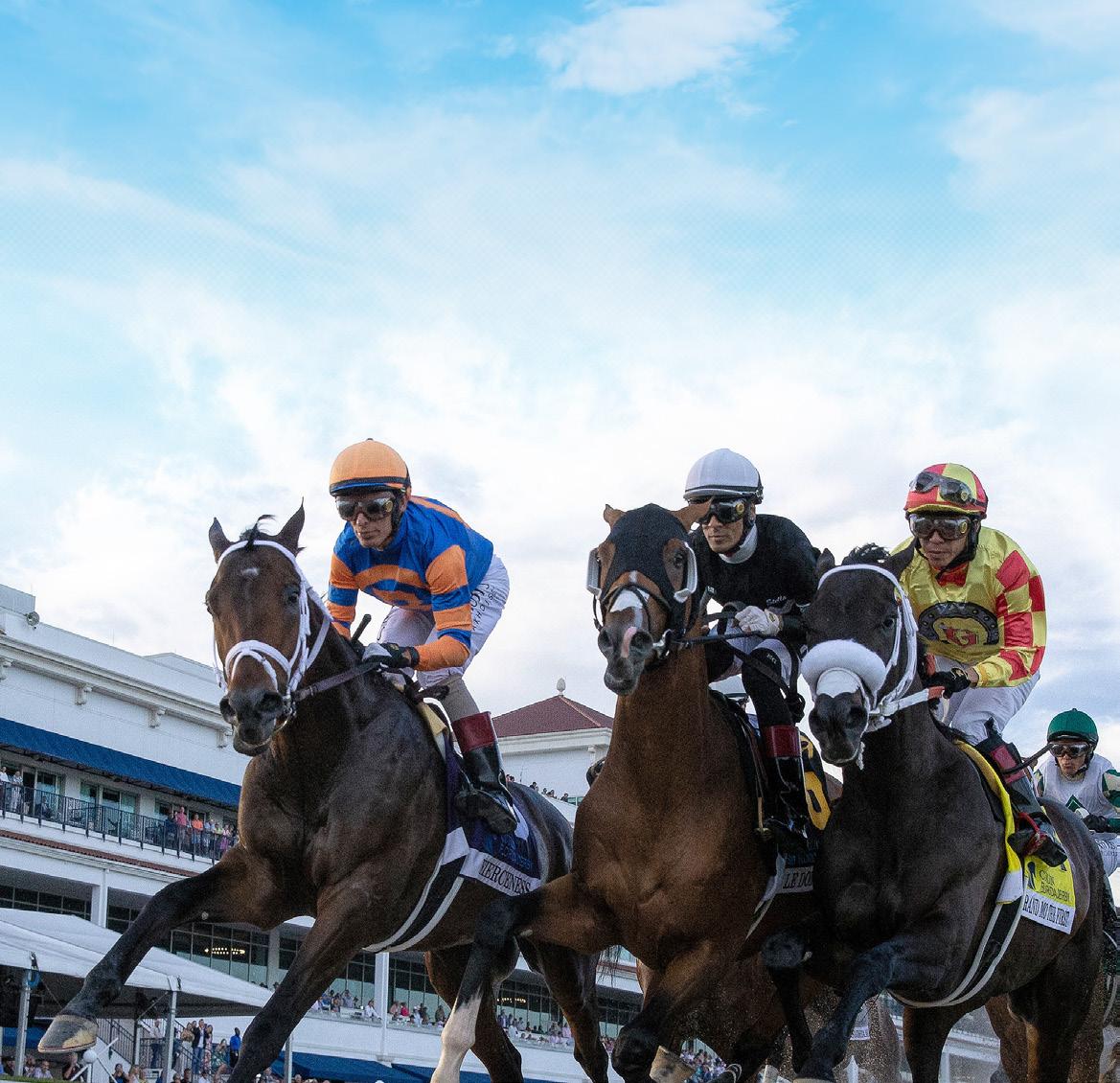


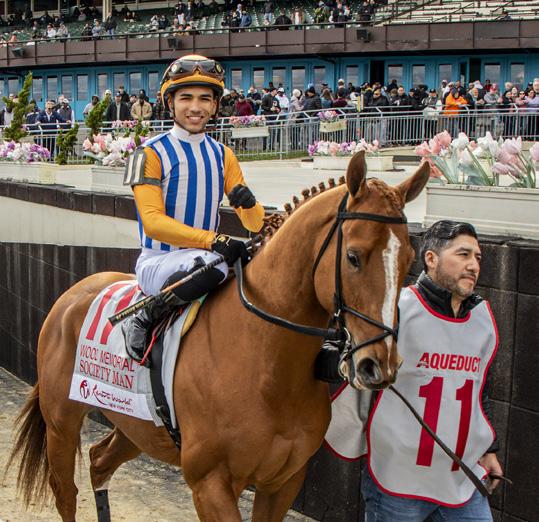

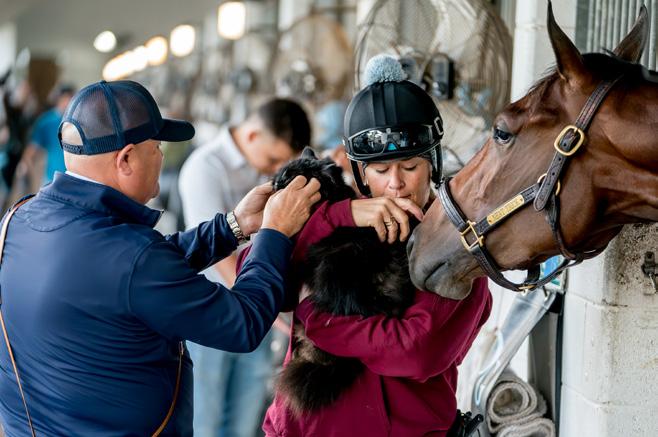


Connolly got involved with two partnerships, Donegal in 2014 and then Starlight. Connolly was able to enjoy the winner’s circle after Donegal’s Keen Ice upset Triple Crown Champion in the 2015 Travers Stakes at Saratoga.
Connolly said Royal Dornoch is his favorite golf course in Scotland. One of his partners on the horse is retired baseball star Jayson Wirth, an outfielder who played 15 seasons with the Blue Jays, Dodgers, Phillies and Nationals.
Asked about Dornoch’s Derby pursuit, Connolly said, “It’s just super exciting. Every day is like Christmas Eve. What gets me excited about Dornoch is, he looks the part: size, grit, determination.”
West Paces Racing, Gargan and GMP Stables LLC are the owners of Society Man, who was stepping up to graded stakes company in the Wood off an impressive maiden victory. Three starts back, Society Man was eighth in the Grade 3 Withers. “He had a rough trip in the Withers,” Gargan said. “We’ve always liked him. He’s a nice horse.”
Gargan said Dornoch is bigger than Society Man, another son of Good Magic out of You Cheated by Colonel John. ‘They breeze together a lot,” Gargan said. “He worked with Dornoch for the Remsen.”
Asked about Society Man’s jump up in class in the Wood, Gargan said, “Sometimes you roll the dice and it works out. He’s improving at the right time and he can get the distance.”
Dornoch’s work tab was modest as he prepared for the Blue Grass Stakes on April 6th. “We just wanted to keep him healthy and sound,” Gargan said. “He’s a big colt. He can be playful. A little rambunctious. He’s not mean. He’s a big strong horse, just under 17 hands. He’s just under it.”
After his Fountain of Youth victory, Gargan told a TV interviewer that he guessed he had Dornoch at 85 percent for his three-year-old debut. The obvious goal is 100 percent on the first Saturday of May. “I don’t think we’ve seen the best from him,” Gargan said. “He’s going to be fun for a long time.”




$300,000 GUARANTEED
THE GEORGE E. MITCHELL
BLACK-EYED SUSAN STAKES - GII
Fillies - Three Year Olds // 1 and 1/8 Miles
$150,000 GUARANTEED
THE MISS PREAKNESS STAKES - GIII
Fillies - Three Year Olds // Six Furlongs
$100,000 GUARANTEED
THE HILLTOP STAKES
Fillies - Three Year Olds // 1 Mile // Turf
$250,000 GUARANTEED
THE PIMLICO SPECIAL - GIII Three Year Olds and Upward // 1 and 3/16 Miles
$100,000 GUARANTEED
THE ALLAIRE DUPONT DISTAFF STAKESLISTED
Fillies and Mares - Three Year Olds and Upward // 1 and 1/8 Miles
$100,000 GUARANTEED
THE VERY ONE STAKES
ALL STAKES WILL BE RUN WITHOUT THE USE OF LASIX




$2,000,000 GUARANTEED
THE PREAKNESS STAKES - GI
Three Year Olds // 1 and 3/16 Miles
$200,000 GUARANTEED
THE CHICK LANG STAKES - GIII
Three Year Olds // 6 Furlongs
$100,000 GUARANTEED
THE GALLORETTE STAKES - GIII
Fillies and Mares - Three Year Olds and Upward // 1 and 1/16 Miles // Turf
$100,000 GUARANTEED
THE JAMES W. MURPHY STAKES - LISTED
Three Year Olds // 1 Mile // Turf
$100,000 GUARANTEED
THE SKIPAT STAKES - LISTED
Fillies and Mares - Three Year Olds and Upward // 6 Furlongs
$500,000 GUARANTEED
THE DINNER PARTY STAKES - GIII
Three Year Olds and Upward // 1 and 1/8 Miles // Turf
$100,000 GUARANTEED
UAE President Cup (Arabian) - GI
Four Year Olds and Upward // 1 and 1/16 Miles
$100,000 GUARANTEED
THE MARYLAND SPRINT STAKES - GIII
Three Year Olds and Upward // 6 Furlongs
$100,000 GUARANTEED
THE JIM MCKAY TURF SPRINT - LISTED
Three Year Olds and Upward // 5 Furlongs // Turf
$100,000 GUARANTEED
THE SIR BARTON STAKES
Three Year Olds // 1 and 1/16 Miles


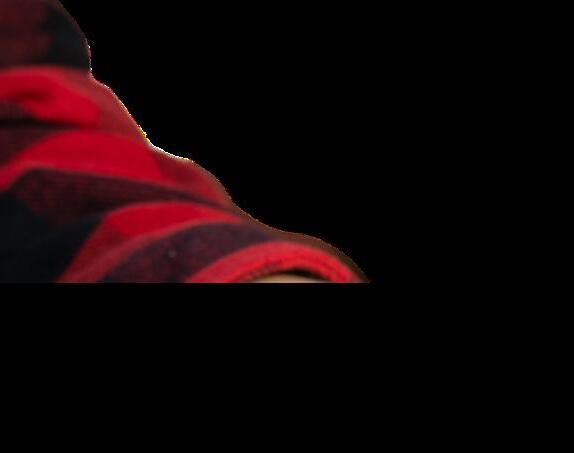
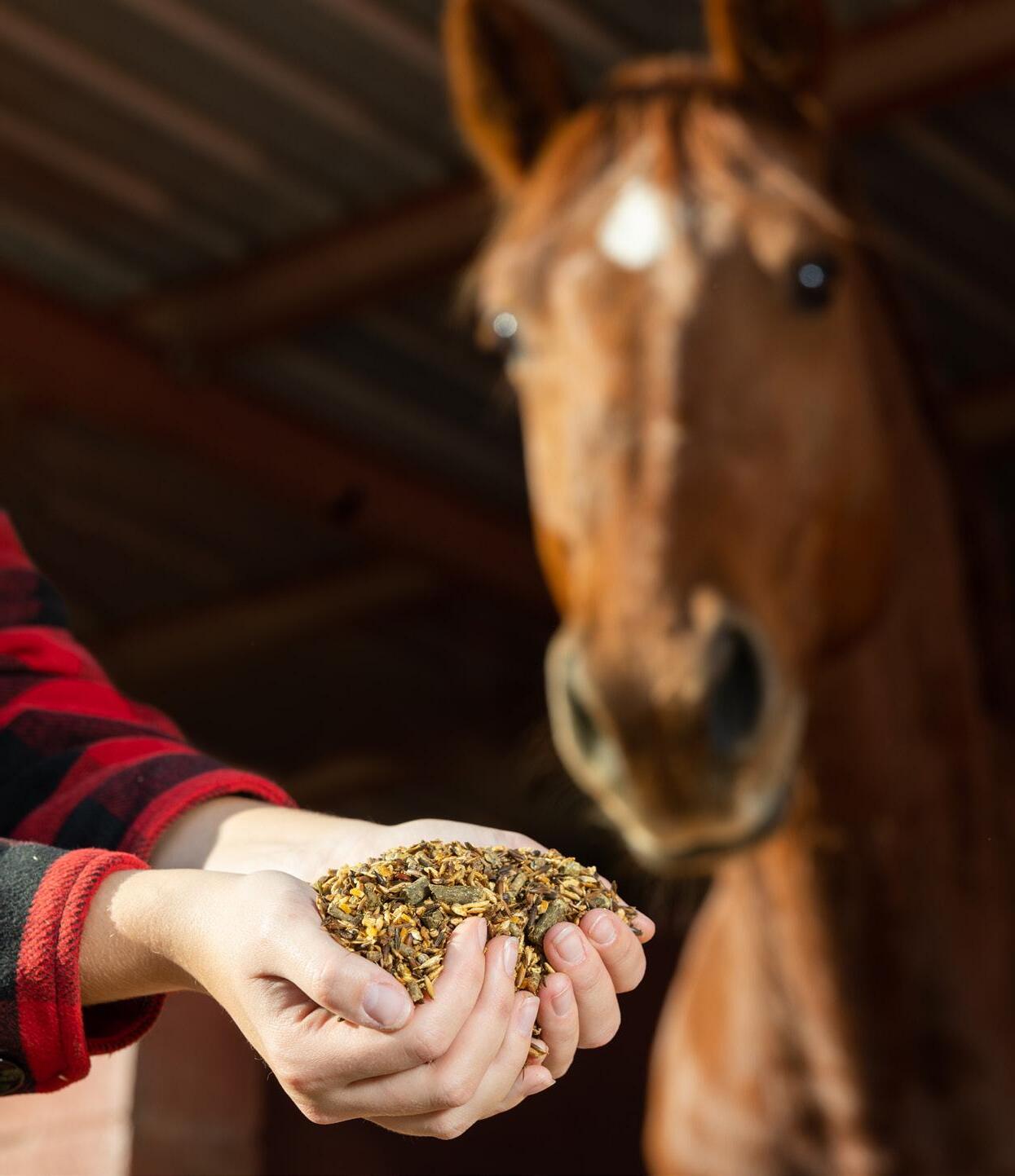

The science of equine nutrition is really quite simple – the horse is a flight animal and in the wild, needs to be able to escape from predators using a short burst of energy. Nutrition and subsequent ‘energy’ for survival is all provided by grass which has the required balance of vitamins, minerals, immune supportive nutrients and fiber to maintain a healthy gut microbiota and keep the horse in adequate health for reproduction.
Proper functioning of the gastro-intestinal tract (GIT) in horses is dependent on a broad range of micro-organisms and more than half of the energy requirement for their survival comes from the microbial fermentation occurring in their enlarged caecum and colon (Chaucheyras-Durand et al 2022). The bacterial populations resident in the various compartments of the horses intestinal tract vary greatly (Costa et al 2015) and there is more DNA in the bacteria located in the gastro-intestinal tract than there is in the entire body. Because of this, having a healthy gut flora is critical to having a healthy immune system.
In modern times, our demands of horses for performance for our pleasure rather than their survival has led to their need for increased energy that cannot be provided from grass alone. Because of this, the intricacies of diet (in particular the
consumption of starch, fiber and fat) has come under scrutiny. Equine feed manufacturers have looked for additional sources of starch, a carbohydrate and a natural component of grass that is ‘essential to provide energy, fiber and a sense of fullness’ (Seitz 2022). Today, most horses and rapidly growing foals are commonly fed diets with >50% of total ration by weight in the form of grain ‘concentrates’ and carbohydrates from oats, maize, soya, barley and wheat These grain based feeds contain high concentrations of soluble, easily fermentable starches but can be deficient in certain minerals and vitamins so getting an optimally balanced feed ‘right’ is difficult.
With advances in scientific knowledge, we now know that when a horse is exposed to surplus starch, the hydrogen ion concentration of their gut increases promoting the production and absorption of lactic acid, acetate and propionate through the activity of fermentation (Ralston 1994). The process is quick, with lactic acid entering the bloodstream within 3 hours of feeding and calcium subsequently being excreted in the urine. In order to combat this nutrient loss, the horses’ immune system triggers the release of parathyroid hormone into the bloodstream, activating the release of stored calcium (to maintain optimal blood levels) but unfortunately causing bone demineralisation.
Clinically, the horse experiences health consequences of varying degrees including digestive diseases (eg. gastric ulcers, diarrhea, colic or colitis), muscle dysfunction (eg. rhabdomyolysis (known as ‘tying up’), defective bone mineralization (expressed as increased incidence of stress fractures and developmental orthopedic diseases), systemic diseases (such as laminitis, equine metabolic syndrome and obesity (Chaucheyras-Durand et al 2022) as well as potential causes of fatigue.
There is little equine focused research available on the benefits of individual nutrients (due to limited numbers in trials and their subsequent evaluation) of grain ‘concentrates’. But we do know that ingredient availability and quality is regularly influenced by market pressures.
The table (Fig. 1) below outlines the sugar, starch and fiber components of the various ingredients commonly found in horse feeds. The optimal grain for equine nutrition with its efficient energy source through lower starch content (relative to other grains) and its high level of soluble fiber (relative to other grains) are oats.
Oats are highly digestible and do not require heat treatment or processing prior to feeding (unlike all other grains). They are the only grain that is easily digested raw and the least likely to cause insulin spikes and blood sugar fluctuations. Unfortunately, oats are not a ‘complete’ nutrient source as they are high in phosphorous and low in calcium. For adequate bone and muscle development as well as proper blood formation, oats must be balanced with additional vitamins and minerals.
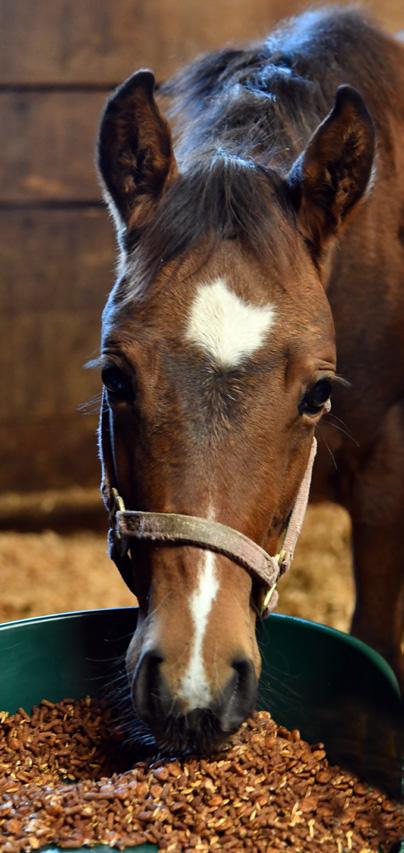
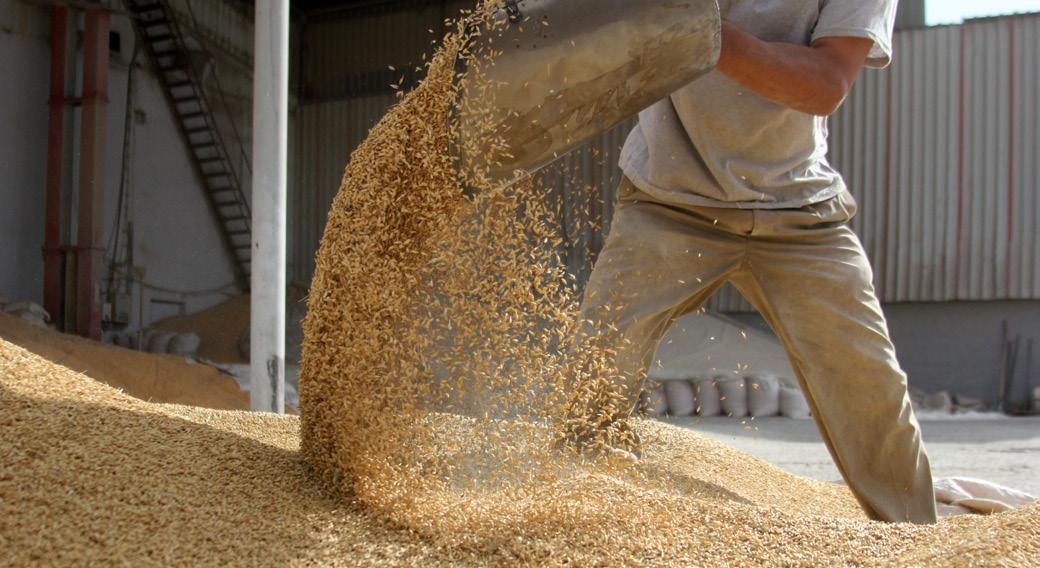
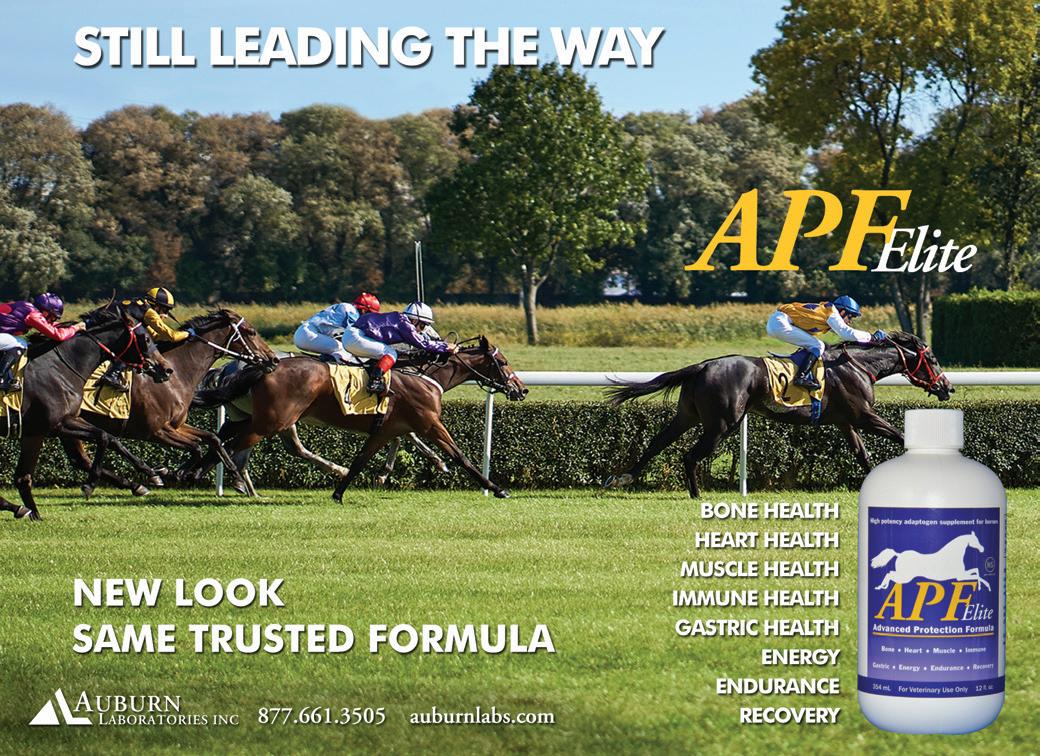
ADVERT BOOKING DEADLINE Tue, July 9, 2024
ADVERT MATERIAL DEADLINE Thu, July 11, 2024 E-ZINE PUBLISHED ONLINE Mon, July 15, 2024
PRINTED MAGAZINE MAILED Mon, July 22, 2024

• Healthy gut flora governs general immunity
• More DNA in bacteria of gut than in the entire body
• Gut Commensals Govern Immunity
• Short Chain Fatty Acids (SCFA) are produced by commensals of healthy gut
While grass provides optimal equine nutrition in its own right, the ‘curing process’ when making hay depletes the valuable omegas 3 and 6 intrinsic in grass. These ‘healing’ nutrients naturally protect the lining of the gastro-intestinal tract by increasing mucous production and alleviating ‘auto digestion’ (via hydrochloric acid). For horses, bacterial fermentation in the hind gut also results in the production of Short Chain Fatty Acids (SCFAs), namely acetic, proprionic and butyric acids. These SCFAs ‘cross talk’ with the gut immune system providing local immunity in the gut as well as protection of the respiratory system, the brain and other tissues against disease. In human medicine, it has been repeatedly established that a dysfunctional gut microbiome is associated with respiratory problems. This is evidenced by the fact that when gut disorders such as Irritable Bowel Syndrome (IBD) or Coeliac disease exist in humans, they are commonly associated with a higher incidence of respiratory infections and related asthmatic like conditions. Barragry (2024) explores the relationship (Fig. 2) between gut microbiome and the immune system’s ability to support health and combat disease in cattle. A scenario mirrored in the equine.
The stabled horse should be provided with SCFAs daily to support proper functioning gut microbiome. This critical dietary consideration should ideally be provided in the form of flaxseed which has the highest ratio of omegas 3 and 6 (in the ideal ratio 4:1) in the plant world and is most suitable for the equine herbivore.
The health benefits of flaxseed for both humans and equines has been recognized as early as 3,000 BC. Flaxseed was used for various medicinal purposes such as the treatment of gastric disorders, as a soothing balm for inflammation and as a laxative (Judd, 1995).
Horsemen (who relied heavily on their equines) and trainers (who sought optimal performance from their charges through natural means) also used flaxseed as a way to supplement the diet with omega-3’s and fiber to produce high quality proteins. Now, thirteen centuries later, we have research to substantiate the knowledge of our ancestors. The renowned German researcher of ‘fats’ and pioneer in human nutrition, Dr. Joanna Budwig, as early as the 1950’s reported that “the absence of highly unsaturated fatty acids causes many vital functions to weaken.” Dr. Budwig’s life’s work focused on the dietary ‘imbalance’ between omega-3 and omega-6 fatty acids in humans has been a cornerstone to the exploration of the role of inflammation and the development of many diseases of the coronary, respiratory, metabolic and immune system.
The small seed of the flax plant is also an excellent source of high-quality protein (exceeding that of soybeans and fish oils) and potassium (a mineral that’s important for cell and muscle function). But, the true power of flaxseed lies in three key components:
Omega-3 essential fatty acids – Also known as “good” fats, omegas enhance the oxygen usage of cells and in combination with alpha-linolenic acid (ALA) are anti-inflammatory in their effect within the body.
Lignans – Flaxseed contains 750 - 800 times more lignans than other plant foods (McCann 2007, Yan 2014). Lignans are a group of compounds with antioxidant properties which also contain plant estrogen. Lignans are linked to a reduced risk of developing osteoporosis, heart disease and cancer.
Fiber – Flaxseed contains both the soluble and insoluble types of fiber essential for maintaining ‘gut’ health.
In equines, adding flaxseed to the diet has the immediate benefits of a shiny, healthy coat and fewer skin allergies. Consistent use of flaxseed has multiple long term benefits including strong hoof quality, improved joint health, reduced muscle soreness, faster healing of ulcers (Sonali et al 2008) and significantly impacts inflammation associated with chronic skin conditions (commonly known as ‘sweet itch’). In breeding stock, increased omega-3 levels in mares’ milk leads to boosted immunity in foals with higher stallion fertility and improved conception rates in broodmares documented (Holmes, 2015).

It is easy to think that ‘providing more is better’ when it comes to using nutrition to support performance. But having excess levels of essential vitamins and minerals being processed by the horses’ sensitive gut has a direct impact on their behavior and willingness to perform.
Today, we have greater ‘choice’ at the feed store with a broad range of commercial feeding offerings available including mixes, mashes and supplements but the discerning horse owner can be forgiven for being overwhelmed by the range of diet options for every ailment and stage of life.
In modern times, despite advances in nutrition offerings, we have seen a falloff in performance (Fig. 3). During the late 1960s, the U.S. Jockey Club stats noted that racehorses averaged 12 starts per year – a far cry from today’s horses racing in the U.S. where the average of 3 ‘starts’ was highlighted by leading U.S. Trainers in 2020 (www.ownerview.com).
Unfortunately, this is not just a U.S. based problem, but a phenomenon noted worldwide.
The first equine pelleted feed was formulated in the U.S. by the Cistercian monks in Gethsemani, Kentucky in 1957. Prior to this, all horses were fed ‘straights’ (primarily oats as their energy source and flaxseed as their protein source). My own understanding of the link between modern feeding practices and compromised performance since the 1960s has been curated off an understanding of “what was different” then, as well as a career of observations, clinical practice and scientific review. Fact is, the equine diet of the 1960s was lower in starch and high in fiber. It consisted of oats, minerals, and flaxseed as the “norm.” Hay was the preferred forage (Fig. 4).

Today, soya (with one fifth of the omega-3 content of flaxseed) has practically replaced flaxseed as the protein source in equine nutrition. This small change has seen a significant drop in omega-3 and 6 (needed for prostaglandins) in the diet with consequential gastro-intestinal and joint issues. Other dietary changes include those recommended by the National Research Council (NRC) in 1978, who suggested doubling the recommended calcium levels for horses with a subsequent increase in levels of Osteochondrosis (OCD) and Osteopetrosis
in the equine population (Krook and Maylin, 1989). Additional moisture in the diet too has led to excess mould formation in convenience feeds and with severe exposure causes liver damage (Buckley et al 2007). Stabled racehorses today mostly lack the nutritional protection afforded a previous generation of horses. The impact has been noted clinically in the widespread increase in equine gastric issues and as stated by J.E. Anthony “Racing fans are missing about half of what they once enjoyed in racing.”
* Buckley, Creighton, Fogarty – ‘Analysis of Canadian & Irish Forage, Oats and commercially available equine concentrate feed for pathogenic fungi and microtoxins’
~ Nitrogen is an iodine antagonist – David O'Connell, B.Agr.Sc, OCAE

The gut microbiome begins populating and diversifying from the moment of birth. Though ‘sterile’ in utero, gut derived DNA immediately drives immune health with exposure to nutrition. Recent research suggests that the gut microbiome can be stimulated by using proven probiotics with a track record in enhancing gut health (Barragry 2024). But it is the protective power of SCFAs to allow ‘cross talk’ between the lungs and the gut microbiome that is critical to supporting horses through their life span.
Nutrition using grain ‘concentrates’ is currently at approximately 99% saturation in today’s equine population so a return to feeding ‘straights’ is a swim against the tide of modernity. But, knowing the influence of nutrition on health, performance and longevity it falls on horse owners to be mindful of the consequential impacts such convenience feeds have on the gut microbiome and immune system. Random supplementation and high starch feeds are leading to dietary
health issues such as gastric ulcers, hyperinsulinemia and hyperlipaemia (obesity) as well as increased risk of laminitis. So trust your gut and keep it simple – a diet of oats, flaxseed, a multi-vitamin balancer and ad lib hay will not only meet your horses’ energy needs but will keep them happy and healthy too.
Sources:
• Barragry. TB (2024) WEB
www.veterinaryirelandjournal.com/focus/254-alternatives-toantibiotics-probiotics-the-gut-microbiome-and-immunity
• Buckley T, Creighton A, Fogarty (2007) U. Analysis of Canadian and Irish forage, oats and commercially available equine concentrate feed for pathogenic fungi and mycotoxins. Ir Vet J. 2007 Apr 1;60(4):231-6. doi: 10.1186/2046-0481-60-4231. PMID: 21851693; PMCID: PMC3113828.
• Budwig, Dr. J (1903-2008) WEB
www.budwig-stiftung.de/en/dr-johanna-budwig/her-research.html
• Chaucheyras-Durand F, Sacy A, Karges K, Apper E (2022). Gastro-Intestinal Microbiota in Equines and Its Role in Health and Disease: The Black Box Opens. Microorganisms. 2022 Dec 19;10(12):2517. doi: 10.3390/microorganisms10122517. PMID: 36557769; PMCID: PMC9783266 www.ncbi.nlm.nih.gov/pmc/articles/PMC9783266
• Holmes, R (2015) Feeding for stallion fertility. WEB www.theirishfield.ie/feeding-for-stallion-fertility-172113
• Judd A (1995) Flax - Some historical considerations. Flaxseed and Human Nutrition, S C Cunnane, L U Thompson. AOCS Press, Champaign, IL 1995; 1–10
• Martinac, P (2018) What are the benefits of flaxseed lignans? WEB healthyeating.sfgate.com/benefits-flaxseed-lignans-8277.html
• National Research Council. 1989. Nutrient Requirements of Horses. Washington D.C.: National Academy Press.
• Ralston, S VMD, PhD, ACVN (1994) The effect of diet on acid-base status and mineral excretion in horses. Journal of Equine Practice. Vol 16 No. 7. Dept of Animal Science, Rutgers University, New Brunswick, NJ 08903
• Seitz, A (2022) What to know about starch. Medically reviewed by Seitz, A - MS, RD, LDN, Nutrition. WEB www.medicalnewstoday.com/articles/what-is-starch#benefits
• Sonali Joshi, Sagar Mandawgade, Vinam Mehta and Sadhana Sathaye (2008) Antiulcer Effect of Mammalian Lignan Precursors from Flaxseed, Pharmaceutical Biology, 46:5, 329-332, DOI: 10.1080/13880200801887732
A liquid, acellular, equine amniotic tissue allograft comprised of amnion and amniotic fluid, intended to supplement and protect tissues. RenoVō® has been used in over 15,000 horses and is enjoying increasing interest among veterinarians as a superior alternative to autologous and other therapies.

“RenoVō® is my go-to product for management of injury to tendons, ligaments, and joints. In my experience, RenoVō®’s combination of efficacy, convenience, and lack of adverse events is unmatched.”
MICHAEL
D.MAJOR, DVM, MS, DACVS


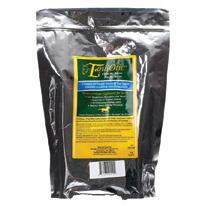
Made from live, species-specific Lactobacillus reuteri and Saccharomyces boulardii; EquiOtic™ is your horse’s first line of defense for gastrointestinal health.
BENEFITS:
• horses under stress of training competition and travel
• before and after vaccinations
• horses with loose stool
• replenish good bacteria; before, during and after antibiotics
• available in powder or paste
• veterinarian formulated and recommended
Available at: bluegrassanimalproducts.com | 859-381-9242

Medical care so advanced it almost makes you wish you were a horse.
We offer every type of medical care your four-legged athlete could ever need. With board-certified specialists in all fields we provide everything from upper airway, arthroscopic and laparoscopic surgeries, to internal medicine, complex fracture fixation and advanced diagnostic imaging, including bone scans, CT scans and MRIs – all in one place. It’s enough to make a human jealous.
800.724.5358
40 Frontage Road Ringoes, NJ 08551 www.midatlanticequine.com






Ask Todd Fincher how he got Senor Buscador from Remington Park to Riyadh and the $10 million dollar Saudi Cup winner’s purse, and you won’t get an answer; you’ll get a bunch of answers.
“There’s honesty. There’s hard work. Being able to evaluate horses and place them in the right spot. The feeding program. Your help. Not cutting corners. All that stuff.”
Got it, Todd. Now, what’s the formula for blending all of that? If it could be quantified and applied, we’d all be Thoroughbred trainers. Todd Fincher can’t tell you exactly how he arrived in the winner’s circle after the Saudi Cup. But there may be a reason why.
“You celebrate in the winner’s circle and then you walk out of there. You have your mind on other things, other responsibilities.”
At the post-race press conference, it was obvious he really had left any whooping, hollering, and hugging back in the winner’s circle. Maybe he smiled once as jockey Junior Alvarado and owner Joey Peacock Jr. fielded questions. There’s pre-occupation and then there’s Todd Fincher preoccupation. His mind was already on “other things,” specifically Sunland Park in New Mexico and his string of 90 horses.
He “came back immediately” from Saudi Arabia, which might have meant a red-eye flight that night. He came to Saudi Arabia as he departed, with no days or hours wasted with idle time.


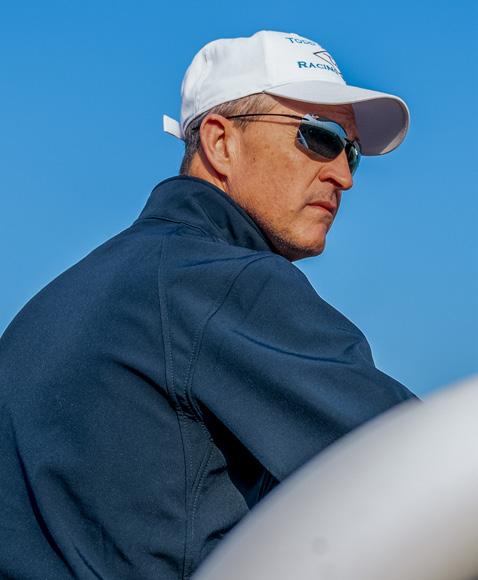

“I didn’t go over until a couple of days before the race,” said Fincher. Instead, he sent assistant Oscar Rojero with Senor Buscador on the 13th of February for a race run on the 24th. Want to know about Saudi Arabia? Rojero, not Fincher, is your man.
An assessment of Fincher as a classic “big fish in a small pond” is subject to re-examination only partially because of the Saudi Cup win. Last year he shipped Senor Buscador to Del Mar to win the Grade 2 San Diego Handicap and finished second with two other horses – Flying Connection and Bye Bye Bobby in graded stakes at Del Mar. All total, his horses hit the board in graded stakes in four out of six races in San Diego. It’s not hard to imagine Fincher
duplicating the success he has achieved in New Mexico in racing’s big ponds—Keeneland, Santa Anita, Saratoga, Belmont. Add to that an eye-popping 24% career win rate.
Looking back at Del Mar he understates his success considerably. “That’s starting to compete at the top level. Not Bob Baffert yet, but, you know, with the few numbers we have of those type of horses, I think we’ve done pretty well.”
Take note of that word “yet.” Fincher has thoughts of setting up a division at Del Mar in the future and is venturing into Oaklawn this year with “a few. But not a full string,” he added. Yet...
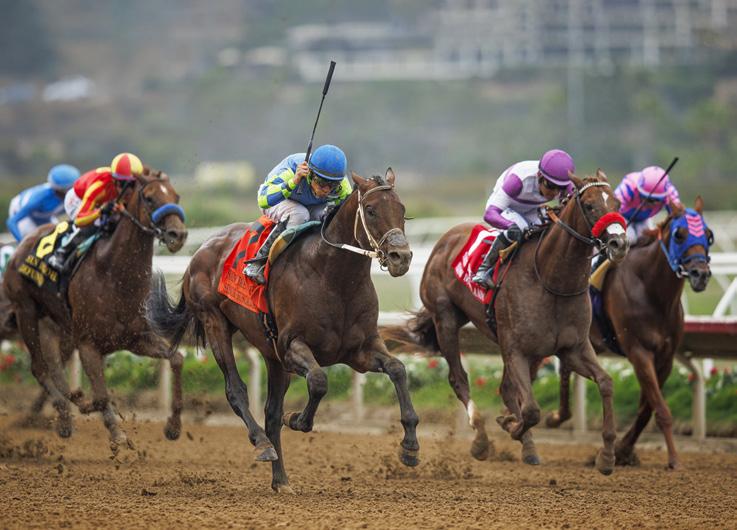
“Big farms aren’t going to look my way because I’m in New Mexico and I understand that, but I will eventually, maybe this year, start running two separate barns,” He added that he will “keep New Mexico going.”
Fincher is a defender of New Mexico racing and pointed out the state has produced both a Kentucky Derby winner in 2009 (Mine that Bird) and a Kentucky Oaks winner in 2011 (Plum Pretty).
“We got a lot of people in New Mexico who are great horsemen. You can develop a horse through our stakes schedule with good purses.”
If it’s a long way to Saudi Arabia from New Mexico, getting to Kentucky may be more manageable with more promising two-yearolds than ever in his barn.
“Last year when I broke babies, I had two Kentucky-breds. Two fillies and one colt.
“This year I had some people step up and fill my barn a little more. We broke fifteen yearlings this year that are Kentucky-breds or Louisianabreds. It’s just very rare for me to get that many,” he added.

Roots in New Mexico run deep for the 52-year-old Fincher. His grandfather, Albert, was a trainer stabling at the old La Mesa Park in Raton, New Mexico as well as at Sunland. Albert’s son, Leroy—Todd’s father—also trained Quarterhorses and Thoroughbreds after a jockey career. As if that isn’t enough pedigree, Todd’s mom Leslie trained Quarterhorses and Thoroughbreds.
It is said that half of life is just showing up. Fincher has had only the other half to figure out. The major lesson he got from family was “Show up every day to work. That’s basically what I derived from my family.
“I worked in the barn. We had jobs at the barn. I would do the water buckets and he would do the hay bags. We were in charge of holding horses for the baths and raking the shedrow. I’m talking from an early age—probably nine, ten years old.”
New Mexico racetracks were also a playground for the Fincher boys. “Your parents would be working, and you’d be running around the grandstands walking back to the barn screwing around and just running loose basically.”
“Play” also included putting down a bet or two at the betting windows with mutuel clerks who knew the Fincher boys. “I could barely reach up to the window. I‘d put my two dollars up there and bet at an early age. That was illegal, but back then everything was a little quieter. “
Fincher’s dream was to follow in the family bootsteps and become a jockey. The lanky, six-feet tall averaged a respectable 14% win rate before waving the white flag to weight after ten years of riding in 1997 and immediately hung up his own shingle the next year. Fincher never worked as an assistant but started with eight horses, the most expensive of which was $5,000.
Transitioning from jockeying to training might have been the equivalent of a family doctor performing brain surgery.
“The one thing that really shocked me about training is how much I didn’t know.
“You’ve heard jockeys don’t make good trainers. That’s basically because they’re two completely different jobs.
“There’s a lot of jockeys that don’t know horses. They just learned how to ride a horse and that’s all,” he added.


He believes his time on the ground grooming as an adolescent and teenager for his dad taught him the importance of understanding a horse. When it came time to sit astride one and break from the gate, that experience was invaluable…to a point.
“I could get on a horse and tell you everything about it…evaluate the horse.
“As a trainer watching, it was a brand new thing. It took a long time to be able to watch a horse and differentiate certain things about a horse—how good they looked when they were running, if they’re just average. Watching the horse move was the biggest challenge, I think.
“You learn from there, then the next year you get some more horses, and every year from then on. It’s grown, and we’re pointing for the quality and not the quantity. We kind of have both now.”
Fincher says 90% of his horses come to him as yearlings. “If I have somebody bugging me to claim horses, we will, but I really have no interest.
“You claim a horse, odds are you pay twenty-thousand dollars, and you got a twenty-thousand dollar horse.
“We’re looking for the home runs to develop a horse into a classic-type horse or stakes winner—the top level.”
Mission accomplished. They don’t get any more top level than Senor Buscador and the Saudi Cup and Fincher knew it.
He was confident the horse could beat the best in the world if he got an honest pace.




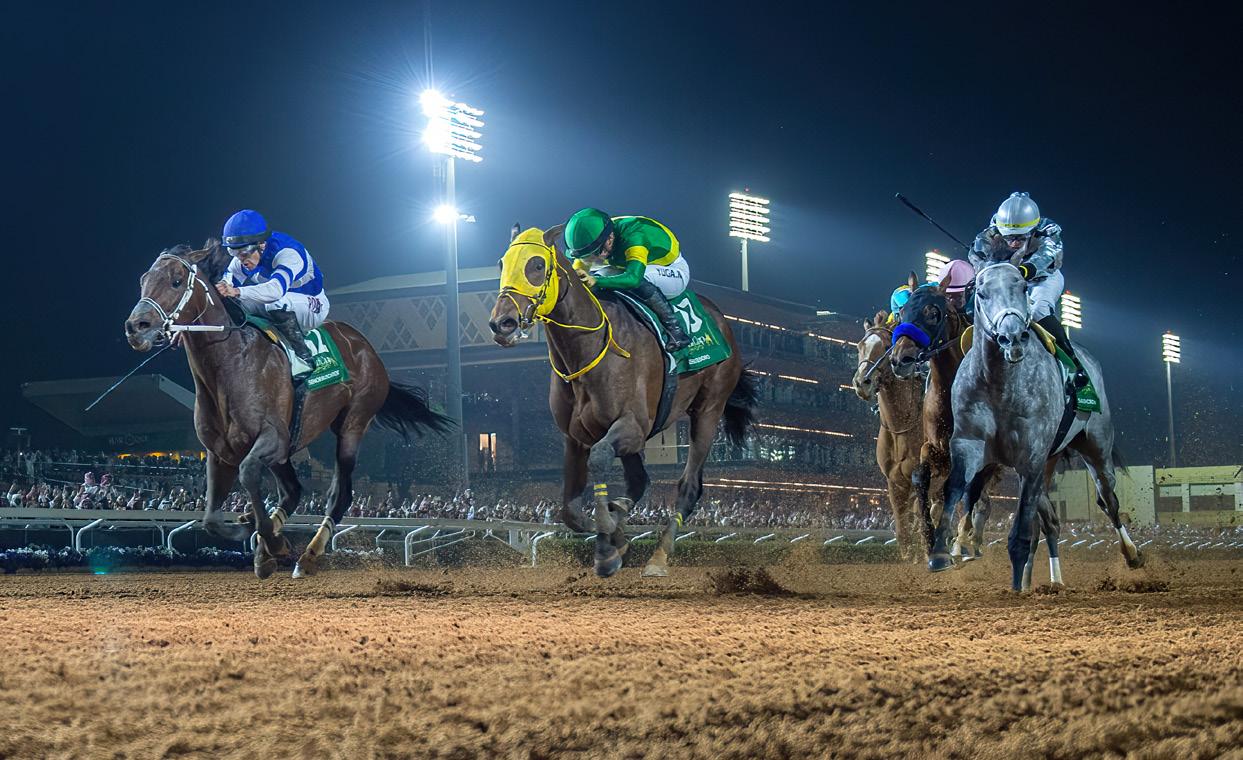

“As far back as he gets, he can get himself in a lot of trouble,” said Fincher. True to form, Buscador was far behind the field by as many as six lengths, loping along next to Japanese starter Ushba Tesoro. Entering the stretch, Senor Buscador fell in behind the Japanese entry then popped out from behind him to the outside. Again, true to form, he spotted Ushba Tesoro as much as three lengths in the stretch before cruising by ten horses, including his Japanese runner by a nose at the wire.
“I think he just lets them get after it first and enjoys running by horses. That’s exactly what it is. He’s got enough speed. He can go to the front if he wanted but he refuses.”
For Fincher, with his total focus, it’s not hard to believe that “validation and vindication” for Senor Buscador meant more than the purse.
“Everybody talks about the purse, which is outstanding. For him to beat the best horses in the world was much, much greater for me than the value of the race.
“I’ve been making excuses for this guy for a long time knowing how good he is.”
Adapting to the horse rather than the other way around might have been still another additional factor in the win. “If I really tried, I guess I could probably change his running style, but I think it would be detrimental to him.
“The ability is there, and I think he’s the best horse. I don’t question that.”
Fincher’s abilities as a trainer sort of mirror Senor Buscador’s performance in the Saudi Cup.


All the horse needed was a clean trip. All that Fincher needs is the opportunities. Racing has probably not seen the last of him at center stage like the winner’s circle at King Abdulaziz Racecourse, but you’ll have to hurry to catch him before he’s gone.
Other things. Other responsibilities.
Todd Fincher would amend lyrics to an old song from the 1950’s movie Cinderella “A Dream Is a Wish Your Heart Makes” to “A Dream is a Wish your Hands and Feet Make.”
The dots don’t connect between Sunland Park and Ruidoso Downs in New Mexico and King Abdulaziz Racecourse in Saudi Arabia and Meydan Racecourse in Dubai… unless you’re Todd Fincher.
A win in the $20 million Saudi Cup with Senor Buscador and a third place showing in the Dubai World Cup (earning a mere $1.2 million) are dreams most trainers wouldn’t ever entertain.
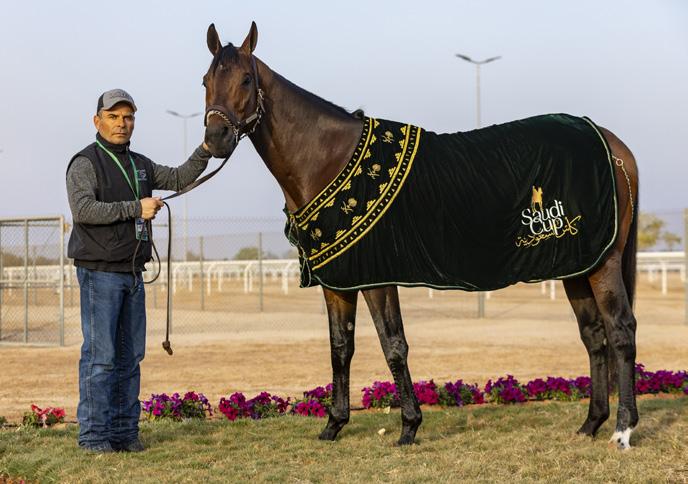
For those who know him any length of time, it is no surprise to hear him say on reaching the highest of heights in racing, “I’ve always been planning on it and hoped to get there. Those are goals that I set. I hope we can reach some more goals pretty soon.”
Gulp.
At first you might not take him seriously until you consider that, well, he did it once, and yes, he did it based in Sunland Park, New Mexico.
Asked what he did after Saudi Arabia and Dubai, the laconic cowboy simply said, “Came home and went back to work. That’s what we do. Go to work every day.”
And make dreams come true

$100,000 G
RUIDOSO DOWNS (5/24 - 9/2)
Mountain Top TB Fut. $150,000 A
Sierra Starlet $50,000 G
Sierra Blanca $50,000 G
Land of Enchantment S. $50,000 G
Lincoln S. $50,000 G
Road Runner S. $50,000 G

Rio Grande Senor TB Fut. $125,000 A
Rio Grande Senorita TB Fut. $125,000 A
SUNRAY PARK (4/12 - 5/19)
Russell/Helen Foutz Distaff $70,000 G
Jack Cole S. $75,000 G
The Kendrick S. $75,000 G
DOWNS AT ALBUQUERQUE (8/29 - 10/27)
Casey Darnell Hcp. $80,000 + G
Carlos Salazar $80,000 + G
Casino



Superhorses created in the lab? Is genetic doping a real “thing”? It’s time for a reality check and a good, hard look at what’s real, or even possible, and how it can hurt or help the Thoroughbred industry.

Breeders, trainers and owners continually seek a competitive edge, striving to produce horses with the speed, stamina and resilience needed to succeed on the racetrack. Concurrently, there is increasing pressure and responsibility to minimize animal discomfort, injury and death in a public forum. Therefore we must carefully examine and balance all the tools at our disposal before determining which ones to use and how.
Interestingly, there is a growing technology that may be of more notable controversy than even horse racing: The power of genetics. Perhaps the greatest power man has ever wielded, genetics has sparked numerous debates over the good and evil it can bring. As with most new things, there is a significant fear of the unknown, so how do we even begin to understand it? In short: research, homework and fact-finding. Let’s look at what is fact, scientifically known, and possible today, and then consider what may be possible in the future.
DNA, often called the “blueprint of life,” holds the key to a horse’s inheritance and development, from its physical prowess, size and speed, to temperament and abilities. By studying their genetics, we can unravel the intricate code that dictates the pre-existing traits and characteristics of these powerful athletes. This information can then be utilized in our breeding and performance programs to improve suitability and success, all while upholding ethical standards and preserving the integrity of the sport.
The general rule for Mendelian traits is that a foal inherits one allele from each parent for a given gene. If the inherited alleles are the same, the horse is called homozygous for that gene. If they are different, they are heterozygous. As heterozygosity goes up, genetic diversity is increased, resulting in more variation in the genetic content. This results in a greater adaptability to environmental stressors and change, leading to a more robust animal and population. With equine genetics, we tend to focus on three kinds of genes: Causatives – genes/variants that directly cause a trait or condition, Correlatives – genes/variants that appear alongside, or in common, with a trait or condition and Risks – genes/variants that increase their likelihood/ risk of acquiring that trait or condition.
A Thoroughbred study by Momozawa et al. found an association between the dopamine D4 receptor (DRD4) gene and a measure of temperament. In the study, “curiosity”, defined as “an interest in novel objects and a willingness to approach them”, was prevalent in horses with a particular gene variant. Horses preferring to observe carefully, from a distance, were of the opposite variant type, named “vigilance”. Although further research is required, it is not unreasonable to consider that temperament affects a horse's ability to learn, break from the gate, or handle the pressure of large crowds on race day.

Another performance trait, perhaps of more notable interest to Thoroughbred enthusiasts is the “speed” gene, myostatin (MSTN). This insertion results in increased muscle growth in horses and other mammals. Genetically, horses can have two copies of the “Sprint” variant, two copies of the “Endurance” variant, or one copy of each, “Sprint/Endurance.”
Thoroughbreds homozygous for the Sprint variant tend to excel earlier in age, at shorter distances (8 furlongs or less) with quick bursts of speed. Horses homozygous for Endurance excel later, and at longer distances (9 furlongs or more). However, heterozygous horses won at all distances, having both quick bursts of speed and endurance capabilities (Fig. 1).
Speed: Endurance
Temperament: Curious & Vigilant
Genomic Inbreeding Value: 15.670%
Using genome-wide association studies (GWAS), scientists can analyze equine DNA and identify specific genes associated with various health and performance traits. This research holds immense promise, pinpointing genes responsible for desirable traits like speed, temperament, gait, size, and overall health. So how can we use it to produce horses with optimized genetic profiles for racing, while minimizing risk and injury? The answer lies within our breeding programs.
This horse is genetically Endurance/Endurance, making her more likely to excel at lengths 9 furlongs or greater. She also carries one copy of Vigilance and one copy of Curiosity, which studies indicate may affect her interest in novel objects and willingness to approach them.
Explanation of a Thoroughbred’s genetic speed, temperament and genomic inbreeding value.
bloodlines possess underlying genetic traits that express and complement one another. Given science today, the next evolutionary step in this process is to genetically test and confirm the desired traits are present and will be passed on in the most advantageous combinations.
For generations, breeders have been making selections for observed traits, such as pedigree, racing history, prior offspring performance and conformation. Additionally, “Nicking,” the strategic crossing of certain lines with an observed affinity for one another, is another well-known method used to make breeding decisions. These techniques may be successful, as the chosen

Mare
Genomic
STALLION

Foal
Genomic
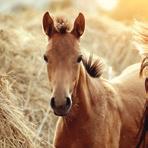
Foal
Genomic
Inbreeding (having drastically reduced genetic diversity) poses a significant challenge within the Thoroughbred racing industry due to the closed nature of the studbook. Science shows that a 10% increase in inbreeding reduces a horse’s likelihood of successful racing by 7%. Essentially, higher genomic inbreeding correlates with poorer performance. Traditionally, we have relied on pedigree and conformation to make mating decisions. Today, using actual genetics, we can calculate accurate genomic


Mare
STALLION
Breeding the same Sire to two mares may yield foal crops of drastically different inbreeding percentages based upon the original inheritance of the parents.

Foal 1
Genomic Inbreeding
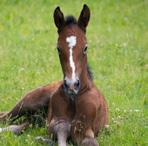
Foal
Genomic

inbreeding and work toward decreasing it. On paper, two mares (full siblings) would appear to have the same inbreeding value. In reality, they can differ greatly, and if bred to the same stallion, may produce foals with drastically higher or lower enomic inbreeding values (Fig. 2).
Using myostatin again, let’s look at a stallion that, by conformation and pedigree, appears to be the perfect match for your mare. Genetically, the mare is Sprint/Endurance and the stallion is Sprint/Sprint. This would result in a foal who is 50% likely to be Sprint/Endurance and 50% likely to be Sprint/Sprint. Now, if you breed that same mare with a stallion who has, at a minimum, one copy of endurance, the foal would still have a 25% chance of being Sprint/Sprint. However, it would also have a 50% chance of being Sprint/Endurance and a 25% likelihood of being Endurance/Endurance, giving it longer-distance capabilities (Fig. 3).
Beyond discovering performance-related traits, genetic research plays a vital role in promoting the overall health and sustainability of the breed. Health and soundness risks, such as Recurrent Laryngeal Neuropathy (RLN) or “roaring”, Kissing Spines and Tendinopathy are being actively developed as genetically testable variants. Some of these traits can limit a Thoroughbred's pre- or post-racing career. Other predispositions, like Chronic Idiopathic Anhidrosis (CIA) or “nonsweater,” or Fracture Risk, can be life-ending if they go undetected.
Through the use of genetic testing and associated technologies, breeders can “Build-A-Horse” to their specifications by crossing specific sires and dams using confirmed, heritable genetics, that create that optimal foal. By making breeding decisions based on math and science, we can reduce the presence of undesirable health traits in our programs.
As more Thoroughbred owners utilize genetics, collaborating researchers will continue identifying areas of strength and vulnerability in health and performance. This knowledge empowers breeders and buyers to make informed decisions that preserve genetic diversity and ensure the long-term strength of Thoroughbred bloodlines. Given the considerable investment of both resources and effort involved in the production and training of horses destined for the track, decreasing risk and increasing financial management is paramount. Remarkably, the cost of utilizing genetic testing to ascertain a horse’s optimal race distance is less than one week's feed and can ultimately save owners and breeders both time and money.
Mendelian Inheritance of Myostatin, the “Speed Gene”
For simplicity, the insertion is referenced here as “S,” for Sprint, and “E,” for Endurance.
This figure shows different foal outcomes, with a homozygous vs heterozygous sire.

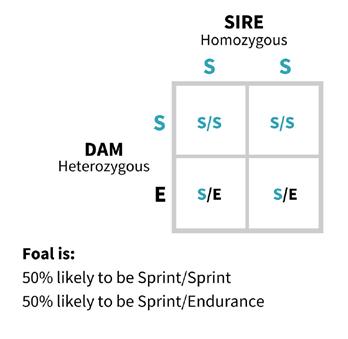
As genetic research becomes increasingly integrated into the Thoroughbred racing industry, it’s wise to approach this technology with foresight instead of fear. Whilst it offers unprecedented opportunities for improvement and advancement, this research also carries the potential for unintended consequences and ethical dilemmas that must be carefully navigated.
The topic of cloning has been hotly debated in the last decade. The first reaction appears to be to “ban” it in certain registries and competitions. Interestingly, the fears stoked by this technology have not materialized into truth for a seemingly simple reason: You can replicate the genetic code of an animal, but it’s another thing entirely to replicate the uterine environment, the training, feeding, life experiences and competition circumstances.
Another recent concern within the industry is the concept of “gene doping” to create superhorses, which involves artificially modifying an athlete's genes to enhance their performance. For example, the myostatin gene may become the target of genome editing in horses, as it alters the amount and composition of muscle fiber types. Although there are no known foals born, to date, with genetically altered myostatin, could it happen? Maybe. Would the effect be instant in something like myostatin? No. Why? Because that’s not how it works! A live animal has a fully formed physical plan in place, especially for things such as muscle, tendons and bone. Today’s most advanced gene therapies tend to be extremely targeted regions, take months to years to work and are extraordinarily expensive.
Assuming it’s possible to change the myostatin disposition of a horse, could we detect that it was manipulated? The answer, according to multiple experts, is a very strong, “maybe”. Technique and timing would matter as would the simple question of “Could this foal’s parents have passed on this genotype?” As technology advances and provides the opportunity for a competitive edge, it’s safe to say that someone will try it. What then? The answer may just come down to numbers, like everything else on the track.
So, with all of this knowledge, can someone choose a bunch of genetic traits and create a Superhorse? Although you hear about it every day, complex genetic editing is just in its infancy. It is possible to change a gene or variant within an embryo. We’ve been doing it for decades already. So why not a Superhorse? Well…consider the following:
1. It’s not easy to insert a single correct genetic edit that results in a living animal.
2. It takes a large number of iterations and time for that one change.
3. The process can be super expensive. Multiply this by many dollars and much more time for every additional genetic change you wish to add.
4. Once you’ve produced genetic change, now you have to wait years to see the foal perform at which point your choice of changes may no longer be the winning combination!
Although we are likely years away from this being a feasible, let alone common issue, we need to take steps now to understand genetics and devise a reasonable path forward. Preventing the misuse of gene editing could be as simple as creating a standardized genetic testing requirement via hair sample in addition to the standard parentage verification. This initial hair sample would serve as a genetic baseline, offering a comparison for those taken at a later date when genetic modifications are suspected.
By adhering to rigorous standards of ethical conduct, transparency and accountability, we can harness the full potential of genetic research while safeguarding the welfare and integrity of Thoroughbred racing.
Genetic research and testing represent a game-changing advancement for the Thoroughbred racing industry. It is a powerful tool for enhancing the quality, health and performance of racehorses – all of which are required to maintain the sport's integrity. As we increase our understanding of equine genetics and discover new traits applicable to the Thoroughbred, we can produce healthier, more competitive horses, while reducing the historical struggles of inbreeding and breakdown. Although we must be careful to adhere to the ethical code set forth within the industry, by utilizing genetics to build the next generation of improved Thoroughbreds we can take ownership of the technology and usher in a new era of excellence and innovation within the sport

Sources:
• Hill, E. W., Stoffel, M. A., McGivney, B. A., MacHugh, D. E., & Pemberton, J. M. (2022). Inbreeding depression and the probability of racing in the Thoroughbred horse. Proceedings of the Royal Society B, 289(1977).
https://doi.org/10.1098/rspb.2022.0487.
• Momozawa, Y., Takeuchi, Y., Kusunose, R., Kikusui, T., & Mori, Y. (2005). Association between equine temperament and polymorphisms in dopamine D4 receptor gene. Mammalian genome, 16, 538-544.
https://doi.org/10.1007/s00335-005-0021-3
• Rooney, M. F., Hill, E. W., Kelly, V. P., & Porter, R. K. (2018). The “speed gene” effect of myostatin arises in Thoroughbred horses due to a promoter proximal SINE insertion. PLoS One, 13(10).
https://doi.org/10.1371/journal.pone.0205664
• Tozaki, T., Ohnuma, A., Nakamura, K., Hano, K., Takasu, M., Takahashi, Y., ... & Nagata, S. I. (2022). Detection of indiscriminate genetic manipulation in Thoroughbred racehorses by targeted resequencing for gene-doping control. Genes, 13(9), 1589.
https://doi.org/10.3390/genes13091589

THIS QUARTER WE EXAMINE THE SIRE LINES WHICH ARE NO LONGER POPULAR AND ASK WHAT HAS CAUSED THEIR DEMISE?
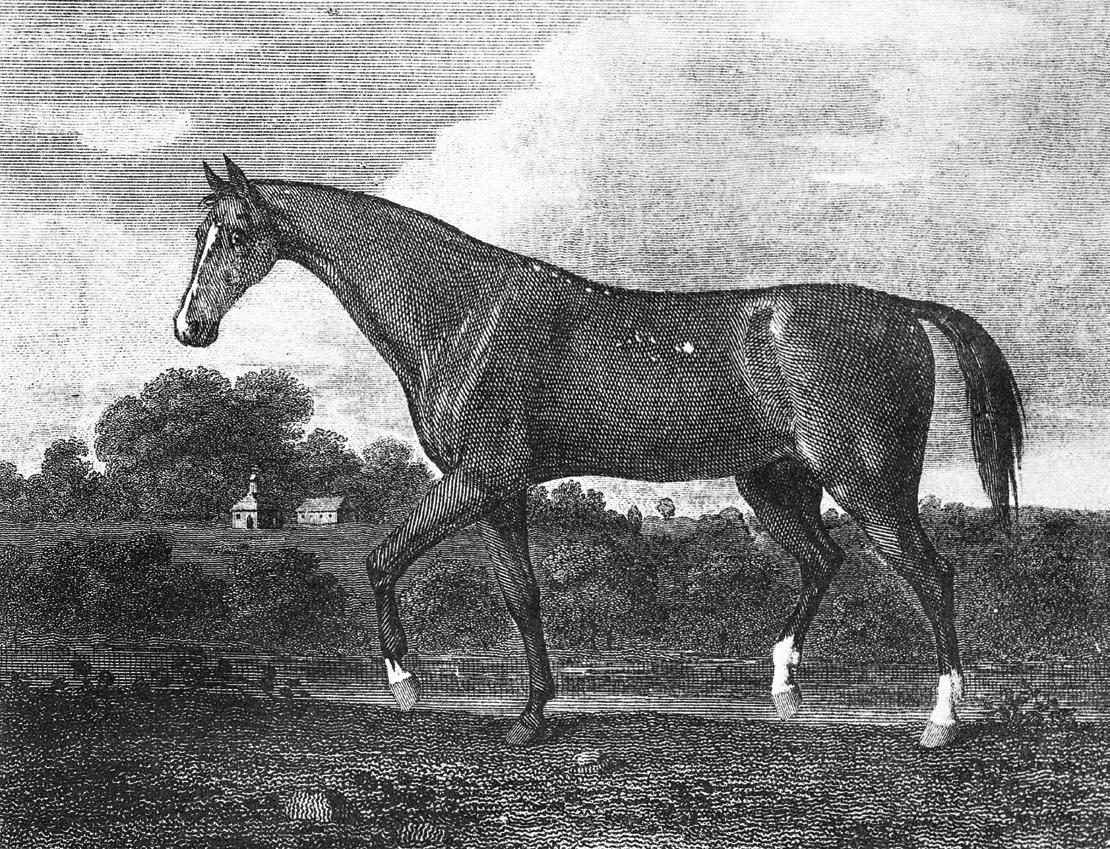
The first breeders of the modern-day thoroughbred had imported 197 Middle Eastern stallions to breed to their English mares in the 17th and 18th centuries, but only three of those stallions’ sire lines are present today – the Darley Arabian, Godolphin Arabian and Byerley Turk.
Of these three foundational sire lines, the Darley Arabian has dominated the bloodstock industry, with both the Godolphin Arabian and Byerley Turk sire lines having dwindled in number. Even with the abundance of the Darley Arabian line, there are branches in this foundational sire’s line which have been lost or are endangered.
To discover why these sire lines are disappearing, we must look at the thoroughbred breed on a global stage. We have gathered pedigree analysts and breeders from Europe, United States, and Australia to examine the less popular sire lines and what factors caused their demise.
Suzi Prichard-Jones (the author of Byerley, The Thoroughbred’s Ticking Time Bomb and founder of The Byerley Turk & Godolphin Arabian Conservation Project) and Alan Porter (a pedigree analyst for Pedigree Consultants LLC and co-creator of TrueNicks) are pedigree experts from Ireland/United States and United States, respectively. John Messara (the founder and owner of Arrowfield Stud in NSW, Australia), David O’Farrell (the operations manager of Ocala Stud in Florida, USA), and Kirsten Rausing (the owner and operator of Lanwades Stud in Newmarket, England) are breeders whose high profile, highly successful, stud farms are shaping the landscape of the thoroughbred breed.

Q.Why do you believe the Godolphin Arabian and Byerley Turk sire lines have become less prevalent?
The pedigree analyst panelists weighed in with a history of these three foundational sires, explaining how the first champion progeny sires, born in the mid-1700s, are a coordinated blend: Herod (Byerley Turk sire line – Darley Arabian mare), Matchem (Godolphin Arabian sire line – Byerley Turk mare), and Eclipse (Darley Arabian sire line – Godolphin Arabian mare).
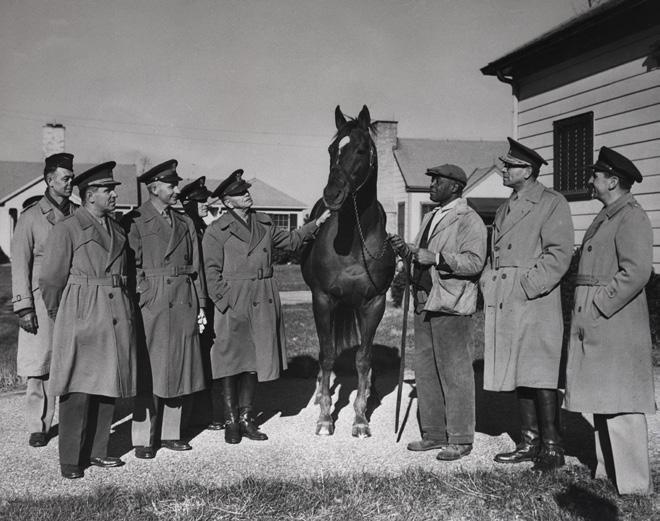
These champion sire lines dominated the breed utterly until the 20th century. The beginning of the fall of the Godolphin Arabian line in America, most recognizable as the Man o’ War line, occurred around World War II when a tremendous number of horses were being imported from Europe.
Alan Porter mentions, “at that point, European horses were just better – dirt, turf, any surface. They swept aside the North American sire lines”. Furthermore, Porter mentions “for a 36-year period (from 1939 – 1974), with the exception of 5 times, a European stallion or son of a European stallion was the leading sire in America”- giving scale to the domination of the European imports in American pedigrees.
During this period, Northern Dancer dominated the global bloodstock due to the mixture of American pedigree and European (specifically Darley Arabian) sire lines.
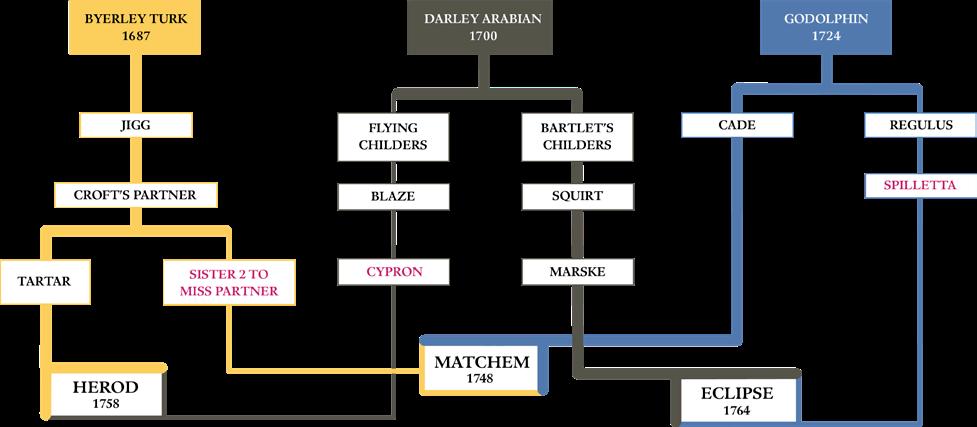
The first breeders of the modern-day thoroughbred had imported 197 Middle Eastern stallions to breed to their English mares in the 17th and 18th centuries, but only three of those stallions’ sire lines are present today – the Darley Arabian, Godolphin Arabian and Byerley Turk.(1)

Name of mares
Male tail line of the female line
Male tail line of the male line
Given the dominance of some Darley Arabian sire lines over others and the shrinking of the Godolphin Arabian and Byerley Turk sire lines, what impacts on the breed do you expect if these sire lines disappear? One of the pedigree analyst panelists, Suzi Prichard-Jones, spoke extensively on this topic. She theorizes the Thoroughbred breed’s success relies on the “balance” between the three foundational sire lines. Due to at least one other foundational sire line being found within the first six generations of every modern Thoroughbred, she believes the traits of the Godolphin Arabian and Byerley Turk are maintaining the breed to be “fit for purpose”.
Prichard-Jones speculates if these two sire lines disappear, Thoroughbreds will be “fast but heartless horses” due to the spirit, temperament, toughness, and hard-headedness characteristics the two sire lines bring. However, we truly do not know what impacts the narrowing sire lines will have as there has been insufficient genetic research available to produce future breed projections.

Q.Does the bloodstock industry place more importance on results in the sales ring or results on the racetrack – particularly involving selection of sires or predicting future success of sires?
Many panelists agreed: most of the market will select only sires whose progeny there will be a market for. Alan Porter mentions, “other than a few very high net worth individuals, a higher proportion of breeders, particularly in the US, are breeding with the expectation of selling” – dictating the change in the bloodstock industry from mostly “breed to race” operations to breeders providing a sustainable sales model.
The panelists concur that the market believes when selecting stallions for breeding mares, the stallion’s own results on the racetrack matter first, then the narrative changes to the sire’s progeny performance after the first few crops.
John Messara follows this approach and states he “is more interested in athletic performance and believes results in the sales ring will follow racetrack success.”
He also mentions that Japan’s current model of breeding, by breeding the high performers with other high performers, has brought significant success on the track across the globe – giving much credibility to their methodology.

However, there are also instances of the opposite, as there are a few examples where “stallions can give progeny better than themselves”, as mentioned by Kirsten Rausing, in reference to stallions such as Danzig, who raced only 3 times in his career and is a sire of champions. This phenomenon is rare however, as the success rate of Danzig’s progeny provide a counterpoint to the conventional wisdom.
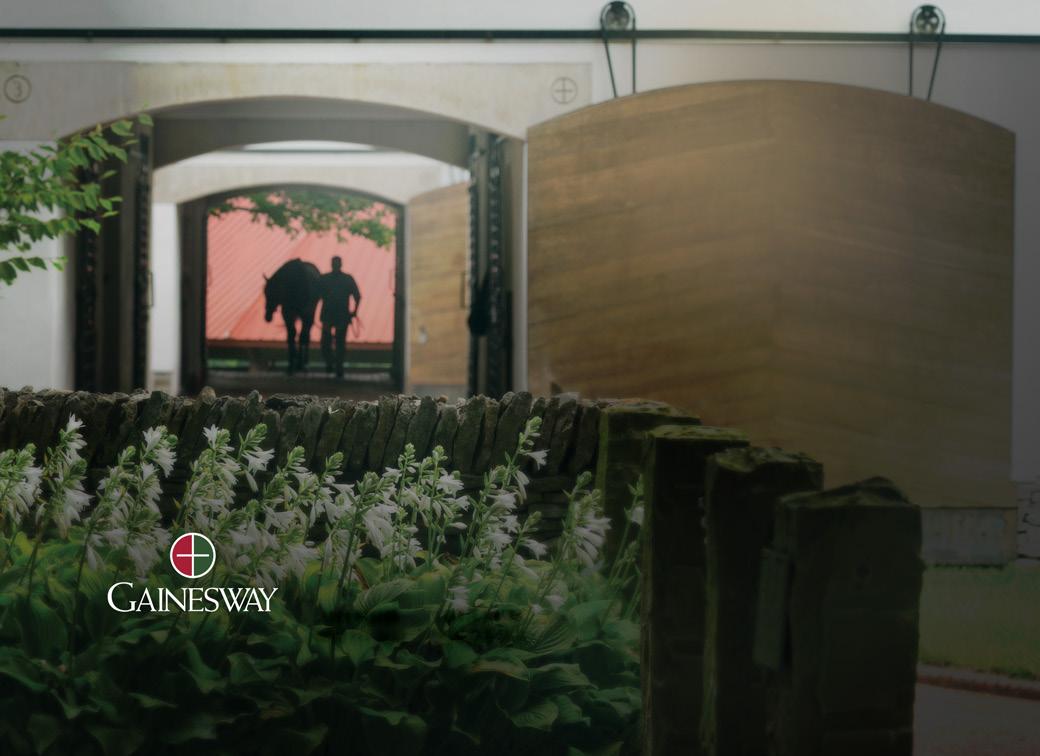

Q.How do we attempt to preserve unpopular sire lines or prevent narrowing the genetic pool of the breed?
Fortunately, there are a few tactics to help: global shutting of stallions and importing stallions to allow for outcrossing. Outcrossing, a practice that brings in “new blood” to the region’s bloodstock, typically crosses stallions who are progeny of successful stallions in other geographical regions and/ or stallions that do not have any inbreeding within four generations with a chosen mare.
David O’Farrell of Ocala Stud says he is “a big believer of the outcross and not afraid to breed to certain sire lines that may not be as fashionable”. Ocala Stud is known for having stallions intended for outcrossing to local mares – many of their success stories include Girvin, Kantharos and the up-and-coming Win Win Win. Similarly, Kirsten Rausing’s Lanwades Stud has had success in “offering breeders and broodmare owners something outside of the ordinary” and a stallion who will “complement the mare population of Europe” including their current stallions Study of Man and Bobby’s Kitten.



Over the years, the industry has seen how the importing of stallions has strengthened the breed to perform well on the racetrack and in modern times, particularly in Australia and Europe, the practice of shuttling of stallions is proving to have similar results.
Through all these discussions, some panelists mentioned a glimmer of hope for the Byerley Turk, Godolphin Arabian and endangered Darley Arabian sire lines. There are multiple examples of sire lines coming back from the brink of extinction – a few favorites from the panelists include Fappiano’s Cryptoclearance line reemerging with Candy Ride (ARG), Nasrullah’s Caro line resurging with Uncle Mo, and the most successful story: Storm Bird’s Storm Cat line with 5-time American leading general sire Into Mischief. Each of these resurgences occurred after the use of the outcross technique, leading to future successful stallions and breathing new life into their sire lines.

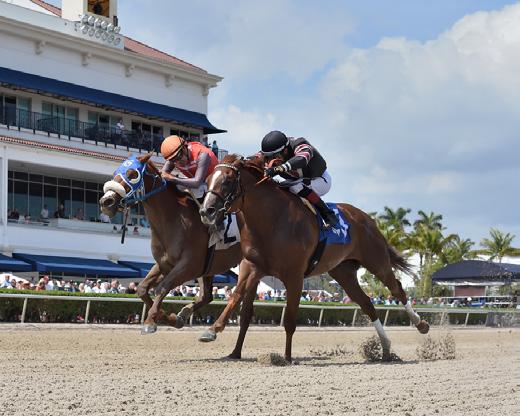


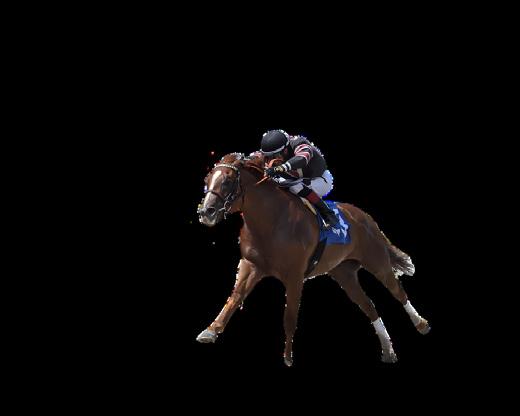
Foal your mare in 2024, in Massachusetts, to make these benefits work for you:
• Benefit from a supplemental incentive of $10,000 – in addition to the purse of any unrestricted race in which a Massbred horse is entered at a licensed pari-mutuel race meeting authorized by the state racing commission.
Supplemental incentive will be distributed as follows: 60%, 20%, 10%, 5%, 3% and 2% to the first 6 place finishers*.
• Benefit from Developer Awards of 20%**
• Benefit from Breeder Awards of 25% and Stallion Awards of 15% – on the supplemental purse awards and racetrack purses.**
• Benefit from Owner Awards of 10% will be granted on the racetrack purse only.**
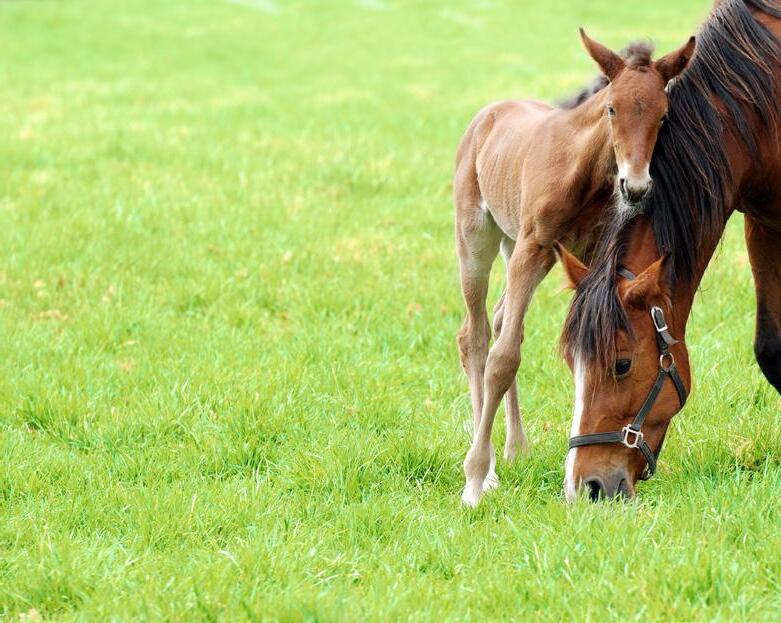
To learn more about the benefits of breeding in Massachusetts, please visit massbreds.com or call us on 508-252-3690

9 individual British Group 1 races have featured in the World’s Top 10 in the last five years, more than any other country.
Lockinge Stakes
Queen Anne Stakes
Prince Of Wales’s Stakes
Eclipse Stakes


King George VI & Queen Elizabeth Stakes
Sussex Stakes
International Stakes
Queen Elizabeth II Stakes

Champion Stakes

Discover how GBRI can guide you on your journey to racing in Britain.
Great British Racing International is British horseracing’s dedicated service provider, committed to helping international parties to navigate the esteemed networks that make up this world-leading industry.


greatbritishracinginternational.com






The Triple Crown has evolved into more than three historic stakes races; indeed, it dominates the first half of the racing calendar, driving the complexion of the threeyear-old division and influencing both owners’ and trainers’ goals for their horses.
The first of the three, the Kentucky Derby, has become the stuff of dreams, inspiring many owners of a young Thoroughbred to pursue their own piece of history. Preparing a horse for the first Saturday in May has taken on a new dimension with the addition of the Road to the Kentucky Derby points system.
How much has this new priority affected trainers’ plans for their Triple Crown hopefuls? While trainers remained focused on preparing their horses to peak in late spring, how they get there has changed in the decades between the first eleven Triple Crowns and the 21st century’s two winners, a change that is both a result of and an influence on the approach to the Derby prep season.
Preparing for a Triple Crown campaign over the last century has been as individual a pursuit as the horses themselves with the approach falling into a pattern in the later decades. Sir Barton went into the 1919 Kentucky Derby a maiden with no starts before his trip to Churchill Downs, a strategic move on trainer H.G. Bedwell’s part: the Derby had maiden allowance conditions at the time, which meant that the son of Star Shoot went to the starting line carrying twelve pounds less than favorites Eternal and Billy Kelly.
Gallant Fox had only the Wood Memorial ahead of the Preakness Stakes, which came first in 1930. Counting that classic, the Fox had two races prior to his turn at Churchill Downs.
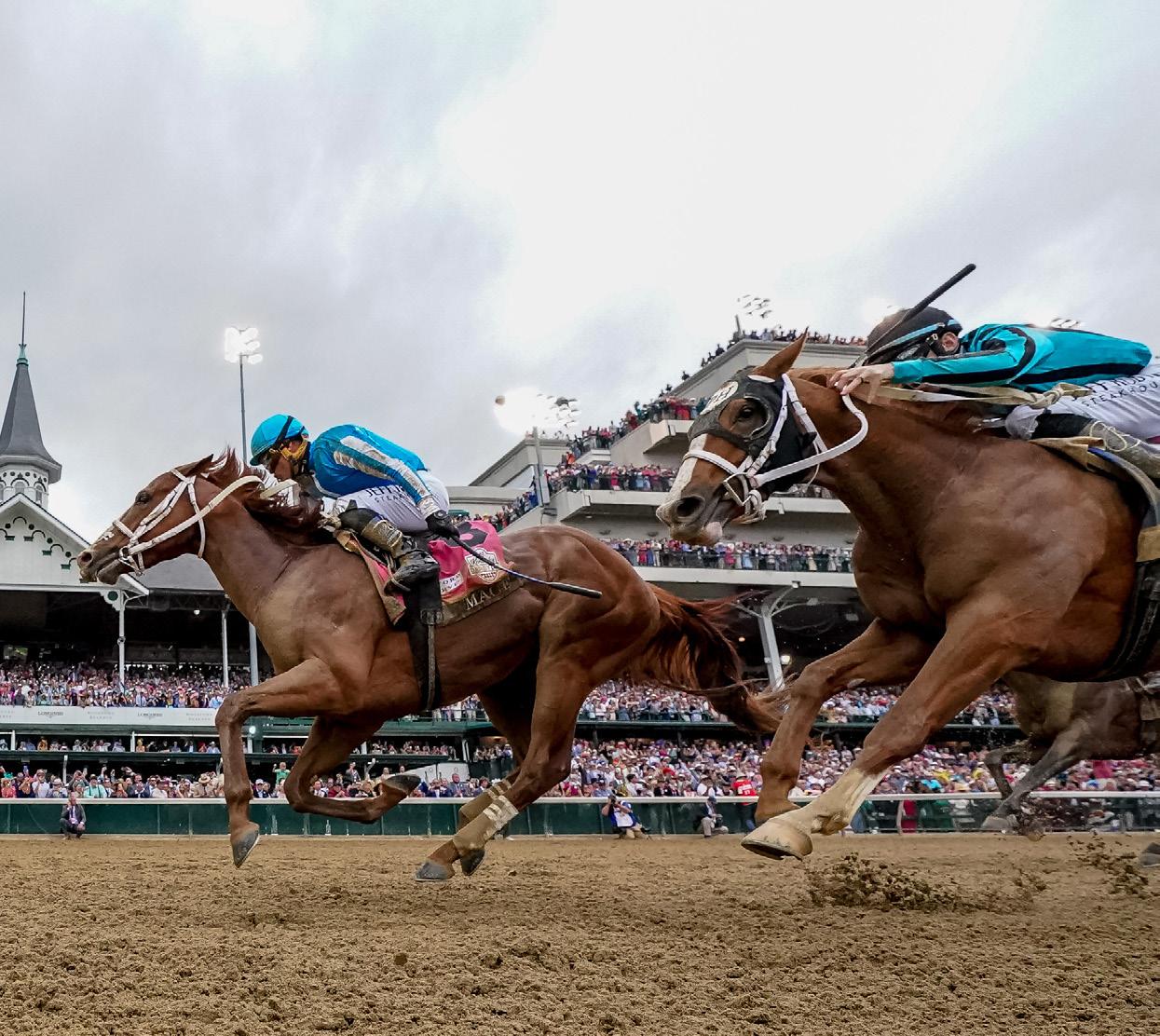
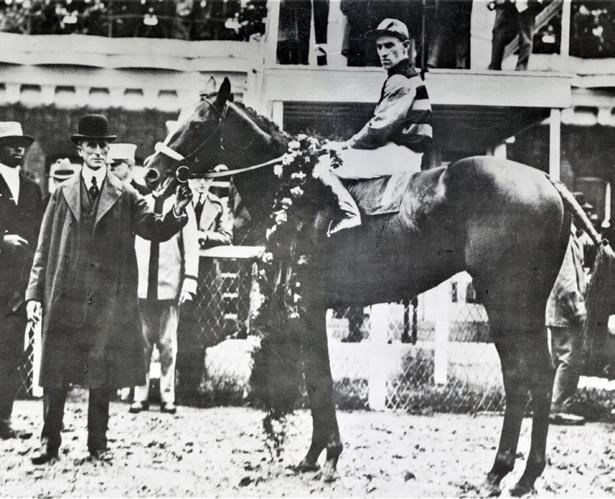

His son Omaha was similarly tested in 1935; he opened his season with a win in a one-mile, 70-yard allowance before finishing third in the Wood Memorial at the same distance. War Admiral started 1937 with wins in a six-furlong allowance and then the 1¹⁄₁₆-mile Chesapeake Stakes before heading to Louisville.
The four Triple Crown winners of the 1940s were war horses not just because of the international context of that decade, but also because of their preparations for the triad of races. Whirlaway raced seven times at distances from 5½-furlong sprints to 1⅛-mile tests between early February and the first Saturday in May and all were in-the-money finishes as Ben Jones struggled to find a solution for the colt’s tendency to bear out on the far turn. Count Fleet echoed Omaha with his two starts in an allowance and the Wood Memorial, winning both. Assault started his path to
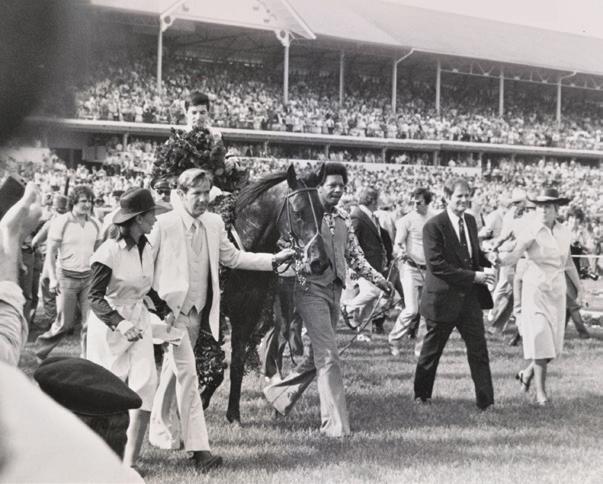
Derby with three starts, a six-furlong sprint, the 1¹⁄₁₆-mile Wood Memorial, and then the one-mile Derby Trial two days before the big race. Citation raced eight times in early 1948, finishing second only once, before his Kentucky Derby, starting with a six-furlong sprint in early February and stretching out to 1⅛ miles twice.
Secretariat’s path to Louisville went through a trio of races in New York, progressively lengthening the distance from seven furlongs in the Bay Shore to 1⅛ miles in the Wood Memorial. Seattle Slew had a similar preparation in 1977, stretching out from a sprint to nine furlongs, while Affirmed started four times, starting with a win in a 6½-furlong allowance, in California before coming west for his 1978 Triple Crown run.
Most of the first eleven winners prepared with races increasing in length as the first Saturday in May grew closer. While the number of races to get there varied by horse, that philosophy remained mostly unchanged, though now the need for points puts a heavier influence on the choice of prep races for potential Triple Crown horses.
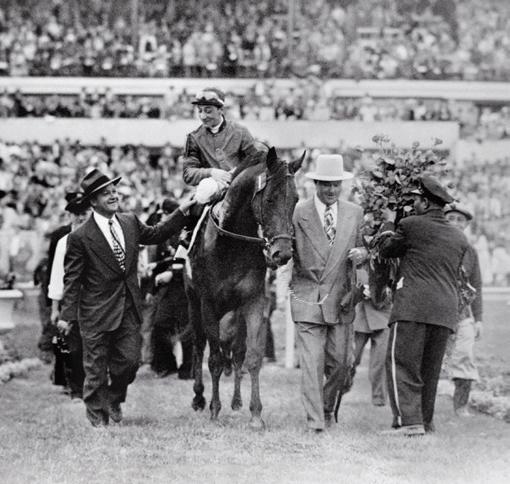
Prior to 2013, the conditions for entry into the Kentucky Derby evolved from paying the entry fees to using criteria like graded stakes earnings to rank potential starters ahead of the first Saturday in May. The oversized 23-horse field in 1974 made it clear that the field size for the first Triple Crown classic needed to be capped. The following year, Churchill Downs limited the field to 20 horses with career earnings as the criteria for qualification. Contrast this with the Preakness and the Belmont Stakes, which both have 14-horse limits.
As 20-horse fields became more common in the 1980s and onward, Churchill Downs had to change their metric from career earnings to stakes earnings to graded stakes earnings. The points system evolved as a fairer solution to the problem of qualifying for the Derby starting gate. In 2024, the Road to the Kentucky Derby series offered 37 races with points ranging from 1 point for fourth place in an early prep to 100 points for the top tier qualifiers like the Santa Anita Derby, the Wood Memorial, and the Bluegrass Stakes. In addition to the traditional American prep races, Churchill Downs has added both European and Japanese Roads to the Kentucky Derby in an effort to make the race more global.
Since the introduction of the points system in 2013, the number of races for North American horses has remained relatively the same, with the inaugural season counting 36 races and the 2024 edition with 37. To make the Derby more appealing internationally, Churchill Downs added the Japanese series in 2017 and the European in 2018.
The series starts with 13 two-year-old races, ranging from one mile to 1⅛ miles, and then picks up steam in mid-January with the Lecomte at Fair Grounds and ends with the Lexington
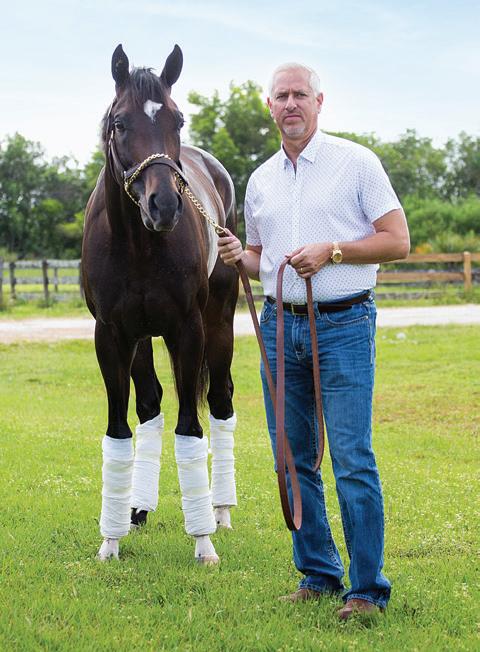

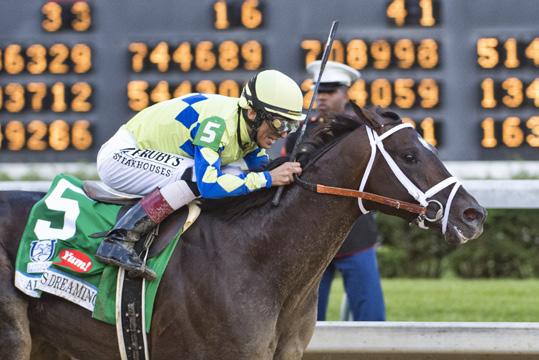
at Keeneland in mid-April. The same-year series starts with one-mile races and expands to multiple 1⅛-mile tests, with the Louisiana Derby clocking in as the longest at 1³⁄₁₆ miles.
With that in mind, how has this shift from graded stakes earnings to points changed how a trainer approaches conditioning their charges for the five-week Triple Crown season?
Hall of Fame trainer Todd Pletcher is no stranger to the Triple Crown season. Since 2000, he has started 64 horses in the Kentucky Derby with two wins, Super Saver in 2010 and Always Dreaming in 2017, and four Belmont Stakes to his credit, including Rags to Riches, the last filly to win the historic stakes.
Looking back at his first Derby winner, the path to Louisville with Super Saver “was sort of an interesting one because we really got behind schedule. After the Tampa Bay Derby, he got sick, which ended up pushing us back a week, and we ended up landing on the Arkansas Derby as his final prep, when generally we would have preferred to have four or five weeks from our final prep to the Derby itself. Seemed like the horse had the best month of his life during those three weeks leading up to the Derby.” Getting the WinStar colt enough graded stakes earnings to qualify for the first Triple Crown classic worked out with his placings in the Tampa Bay and Arkansas Derbies in addition to his win in the Grade 2 Kentucky Jockey Club Stakes the previous season.

In 2017, though, the road to Louisville required collecting enough points to get into the gate. Always Dreaming started his three-year-old season with a win in a maiden special weight and then Pletcher and the colt’s partnership had to make a decision. “The real conversation that we had to have was whether or not we ran in the Fountain of Youth or if we ran in the allowance race the day of the Fountain of Youth. The horse was training exceptionally well, we were very confident that we were on the path to the Derby, and that we had a legitimate derby contender. But in order to make the decision to run in the allowance race, we had to have everyone on board to say that they were willing to roll the dice on one prep race.”
To earn his points, Always Dreaming then had to win the Florida Derby, his lone stakes before the Derby, where “if we didn't finish in the top two, or even if we finished second, it wasn't guaranteed that we would get in based on points,” Pletcher remembered. “Everyone was comfortable with that decision. Everyone wanted to bring him along that way. In this case, we decided to go with that plan and take a shot with one prep race.” The Bodemeister colt won his lone prep and earned 100 points, which guaranteed his place in the Derby starting gate.

Now, the Hall of Famer sees the Kentucky Derby as “more of an event. I remember Carl Nafzger’s ‘I love you, Mrs. Genter.’ […] And then, of course, Lukas and Baffert keeping this thing up. A lot of people just wanted to be in the Derby after that.” The increasing cachet of having a horse in the Derby has driven more owners to chase the points necessary to be in the Top 20 by the first week of May.
Nick Zito won his two Kentucky Derbies in the 1990s, when graded stakes earnings were the standard for qualification, which meant that juvenile stakes wins counted more than they do today. “Go for Gin won the Remsen as a two-year-old and then came back in the Fountain of Youth and in the Florida Derby, and then he was second in the Wood. So he had already qualified,” he remembered, “Basically, today, with the point system, they're just trying to get as many points as they can because they know there are a lot of horses that are trying to get to the Derby.”
If a trainer has a Triple Crown contender in the barn, then the point system changes how they map out the horse’s early starts in pursuit of points. “I think what they're doing is, at two they're trying to break the maiden. Then when they get to three, if they haven't broken their maiden at two, [they] go longer [ ] to try to break the maiden. And after they break the maiden, a lot of them go right into a stakes,” Zito observed. “My theory is they get the calendar out, they see the Jeff Ruby, or they see the Rebel, or they see this race, or that race, or this race, or Gotham, I better go there because I got to get some points.”
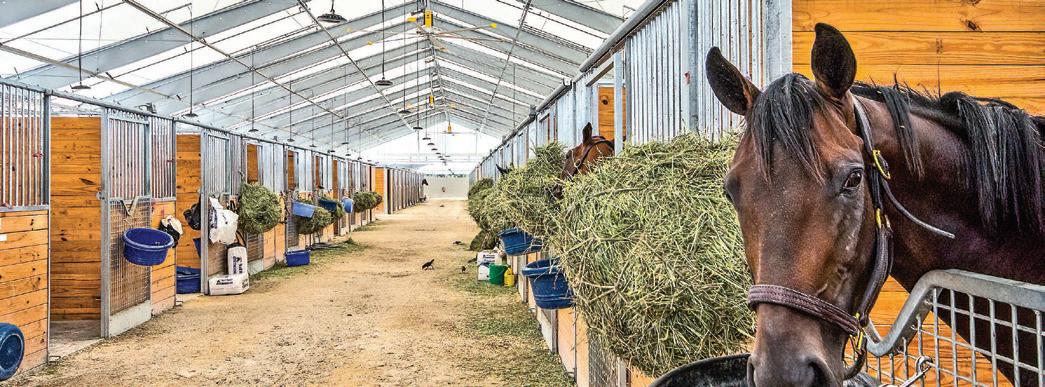



The Road to the Kentucky Derby may have influenced some changes to trainers’ strategies for their hopefuls, but it also has mirrored the trend toward racing less often in order to optimize a horse’s performance. The points distribution plays into that strategy, prioritizing the traditional preps in late spring.
All of the races in the points system are a mile or longer, which favors horses stretching out earlier than they may have previously, making shorter races, even stakes, less of a target. “The point system has, I'm not going to say eliminated, but to a large part, greatly decreased trainers running horses in, let's say, the Swale,” Pletcher observed. “Traditionally, a lot of guys would do that and then go to the Fountain of Youth and Florida Derby and kind of take that gradual route of stretching out. And that's just not the way a lot of people are training. They're going to go straight to a long race, and long races have points.”
“Now most of them concentrate on the bigger races. If they don't have the points to begin with, they're going to have to run in a place where they could qualify,” Zito pointed out. “If you run first or second in one of those, chances are you might get in over horses that have accumulated points during the year. So, basically, it'll come down to those last three days, sometimes.”
This emphasis on points rather than earnings has eliminated the chance for early graded stakes winners and stakes-winning sprinters to get into the gate on the first Saturday in May.
Even if those early winners did not train on at three, they still had earned a chance to try the Kentucky Derby; similarly, sprinters could set or stalk a fast pace early in the race, setting the stage for closers to make their run for glory in the stretch. The points system instead favors classic distance horses, especially those who can win at eight furlongs or longer early in their threeyear-old seasons. With the higher point value preps in late spring, the system minimizes what a horse does in their juvenile season, which means that trainers face a new challenge: how to season a Triple Crown hopeful enough to handle the dynamics of a 20-horse field over ten furlongs while also having them in peak condition for that distance.
LEFT:
Pletcher also pointed out “the other biggest impact is on fillies. A filly would have to step out and run against colts in a final prep in order to earn enough points,” as Secret Oath did in 2022, but only after she had accrued enough points toward a place in the Kentucky Oaks. Swiss Skydiver also stepped outside of her division to run second in the pandemic-delayed 2020 Bluegrass Stakes, which gave her enough points to qualify for the Derby starting gate. In the end, both fillies deferred that opportunity and ran in the Kentucky Oaks, leaving Devil May Care as the last filly to contest the Derby, finishing 10th in 2010, three years before the points system was instituted.
Another trend over the five years has been the decreasing number of Derby starters contesting the Preakness. Other than Super Saver and Always Dreaming, Pletcher has “historically skipped the Preakness with a lot of our Derby contenders, and I think that's a good example of trainer management that's evolved over the years. And taking those horses and giving them five weeks in between the Kentucky Derby and the Belmont is part of the reason why we've had a lot of success” in that final Triple Crown classic.
Zito followed a similar path with his most recent Belmont Stakes winners. “We ran Birdstone, one of the most memorable Belmonts ever, beating Smarty Jones. But he ran in the Derby; he didn't run in the Preakness,” the Hall of Famer observed. With Da’Tara, “he never ran in the Derby, and then he won the Belmont and stopped Big Brown.” His most recent Triple Crown starter, Frammento in 2015, earned his spot in the Kentucky Derby through in-the-money finishes in the Fountain of Youth and the Bluegrass Stakes. After finishing 11th behind American Pharoah, Zito opted to skip the Preakness and instead sent Frammento to the Belmont, where he finished 5th behind the Triple Crown winner.
The Road to the Kentucky Derby is in its twelfth year, the number of horses going from Louisville to Baltimore remaining steady, with an average of four horses making the trip, until 2023, when only Kentucky Derby winner Mage tried the Preakness Stakes. So far, the decreasing number of horses returning for the Preakness may be attributed more to the trend of spacing races out rather than the effects of pursuing points, a phenomenon which has prompted discussion about expanding the gaps between the Triple Crown classics. As of 2024, any changes to the classic calendar remain an ongoing debate without an immediate resolution.
The sport has seen two Triple Crown winners since Churchill Downs introduced the Road to the Kentucky Derby points system. Those two champions plus I’ll Have Another and California Chrome were the only horses to win two or more classics in the 2010s; in the century since Sir Barton, that number echoes most decades except the 1920s and the 1950s. So far, the 2020s have not seen any horse win more than one classic, but the question of what is behind trainers’ changing approaches to the Triple Crown season will require more time to answer.

Talk with your veterinarian today about PSGAG & HA benefits. Trusted by veterinarians for over 20 years.
CHONDROPROTEC®
a sterile solution containing 1000 mg polysulfated glycosaminoglycan per 10 mL
HYCOAT® 10 mL
a sterile solution containing 50 mg sodium hyaluronate per 10 mL (5 mg/mL), AVG REL MW > 1.0 MM Daltons
HYCOAT 2 mL
a sterile solution containing 20 mg sodium hyaluronate per 2 mL (10 mg/mL), AVG REL MW 1.0 – 1.3 MM Daltons
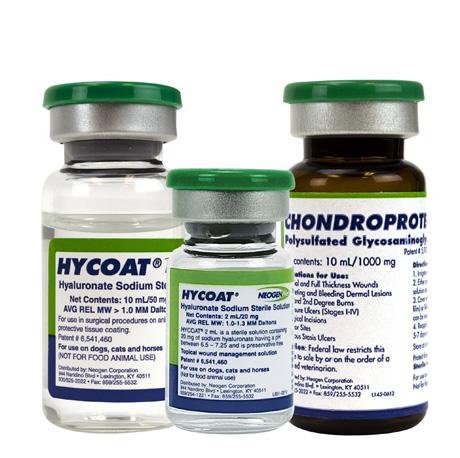


Researchers from the Ontario Veterinary College (OVC) and University of Toronto are developing a novel method to measure the quality of cartilage in horses using electroarthrography (EAG). EAG is a non-invasive technique that uses electrodes attached to the skin around a joint to detect electrical signals produced by the cartilage when it is loaded.
Dr. Adele Changoor, from the University of Toronto and Lunenfeld Tanenbaum Research Institute, and Ontario Veterinary College researcher Dr. Judith Koenig from the department of Clinical Studies, explain how EAG works and why it may become very useful for predicting cartilage quality and diagnosing osteoarthritis and other degenerative joints diseases in horses.
EAG is analogous to electrocardiography (ECG), which measures the electrical activity of the heart. Cartilage produces electrical signals during loading and these signals reflect its biomechanical properties, such as stiffness and permeability.
“By measuring EAG signals, we can get an idea of how healthy the cartilage is,” said Changoor. Healthy cartilage ensures joints can move without pain and has an important role preventing wear and tear on bone.
Currently, there are no readily available tools to assess cartilage quality in horses with the exception of diagnostic arthroscopy – a minimal invasive surgery – under general anesthesia. X-rays and ultrasound are not sensitive enough to detect cartilage changes, and magnetic resonance imaging (MRI) is expensive, requires anesthesia and is often difficult to access. EAG offers a potential alternative that is fast, easy, and affordable.
“EAG is a promising tool for detecting cartilage damage early allowing intervention with treatments that can slow down or prevent further deterioration of the joint,” says Koenig “EAG could also help us monitor the effectiveness of treatments over time.”
EAG measurements were collected at the same time as the center of pressure (COP), which measures the distribution of force under the horse’s hoof when it stands or walks.
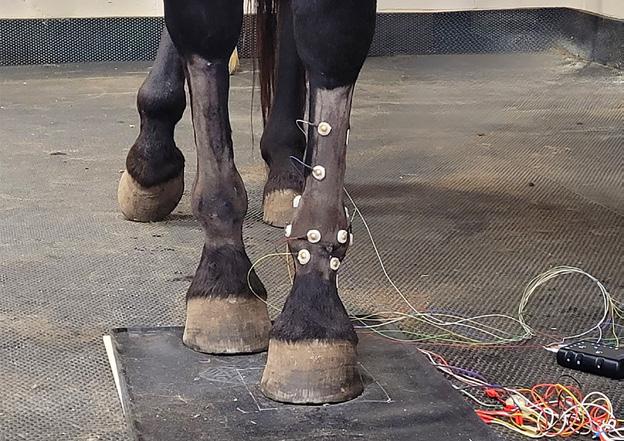


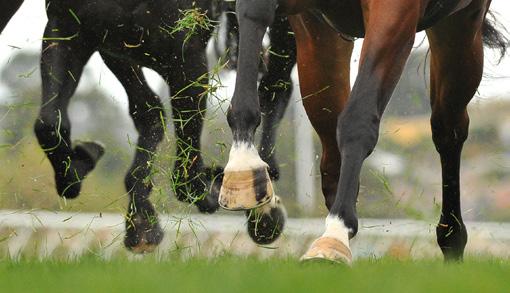

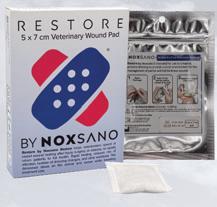


“EAG is really tied directly to cartilage biomechanical properties,” says Changoor. “We also needed to know about the joint biomechanics in order to interpret EAG properly.” A custom, portable, force mat was developed by Dr. Changoor’s graduate students that included an array of force sensors to place under the horse’s hoof when measuring EAG.
“Then we can measure how much compressive force or ground reaction force is being exerted on that joint,” said Changoor. “COP, is where the ground reaction force is acting. The ground reaction force gives us the total load on the joint. COP lets us figure out where on the hoof or where on the joint surface force is being concentrated.”
COP provides information about the joint biomechanics and the horse’s balance and stability. EAG and COP testing were combined to get a comprehensive picture of the joint health and function in horses with osteoarthritis. Results were compared with MRI imaging and it was found that EAG and COP testing correlated well with MRI and could detect differences in cartilage quality between healthy and osteoarthritic joints.
In the 2023 study involving horses with osteoarthritis in the fetlock joint; the horses were treated with MSCs to decrease inflammation and stimulate tissue healing. The researchers measured EAG, COP, and MRI before and after the treatment to evaluate its impact on cartilage quality.
“We observed that MSCs improved cartilage quality in some horses and EAG and COP testing were able to capture these changes and show the responses to treatment. This suggests that EAG and COP testing could be useful for selecting treatment






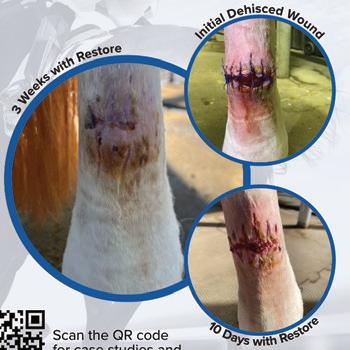

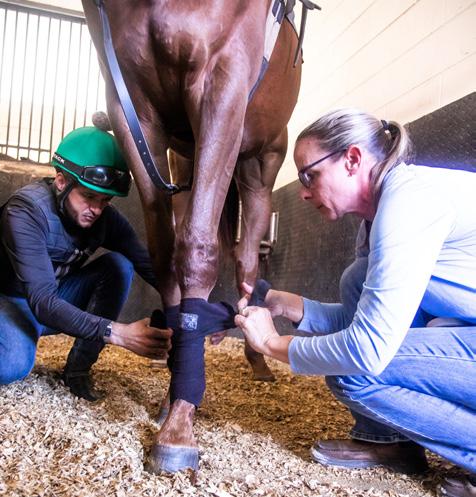

options for the horse,” says Dr. Koenig. “One of the biggest advantages of EAG is that it seems to correspond with our arthroscopic findings. It can perhaps evaluate the quality of the cartilage or cartilage defects, which we are at the moment only able to evaluate with arthroscopy.”
The researchers plan to conduct further studies in order to validate and refine EAG and COP testing for predicting cartilage quality in equines. They hope that these techniques will become widely available and accessible for veterinarians and horse owners in the future.
“This is an exciting and innovative research project that has the potential to improve the diagnosis and early management of osteoarthritis in horses,” says Dr. Koenig “Osteoarthritis is a major health and welfare issue for horses and their owners, and we need better tools to detect it early and treat it. EAG and COP testing could provide a simple, affordable, and accurate way to assess cartilage quality and joint function in horses.”
Many thanks go to the graduate students who worked tirelessly on the EAG study: Peter Suderman, PhD Candidate in the Department of Materials Science & Engineering at U of T, Jaylon Pascual, undergraduate co-op student finishing her fourth year in the Biomedical Engineering program at U of G, Dr Rodrigo Munevar Luque, Equine Sports Medicine Resident at OVC and PhD Candidate Biomedical Sciences at U of G, Undergraduate Research Assistants in Clinical Studies Ashley Nixon, DVM 25 (OVC), Pjotr Roest DVM 26 (OVC), and in Biomedical Sciences
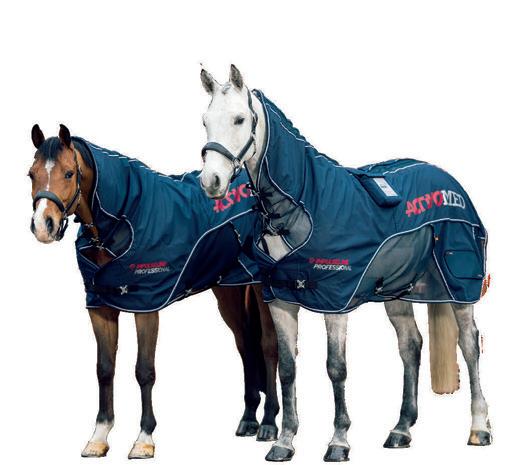



Axel Koenig Parris HBA 25 (Ivey School of Business, Western University) and Rebecca Mullin BSc OVC 25.The study was funded by the Equine Guelph Research Fund and the Natural Sciences and Engineering Research Council of Canada (NSERC). Phone:

Though Eric Waller was 10 years old when he accompanied his father to Santa Anita, he never really felt connected to Thoroughbreds.
His success with Barranca Insurance, which opened in Rancho Cucamonga in 1972 and is now run by his daughters, allowed him to purchase a couple of horses.
“Not Thoroughbreds,” Waller said. “One was a Paint, and one was a Quarter Horse. I wanted horses to ride. I thought that might be fun. It was at that time I realized I did feel something special about horses. I didn’t realize that was inside of me until I bought those horses. I found inner calmness and appreciation for the animal.”
That would be tested after he bought and began breeding Thoroughbreds. His early struggles and then continuing success on the track was tempered by horrible happenings trying to develop a broodmare band. But the Wallers never gave up and they now have a home-bred Kentucky Derby contender, Stronghold, a horse they can proudly point out traces back to four generations of their own Thoroughbreds.
Despite two of their stars dying while giving birth. Despite two mares who savaged their own foals.
Asked how he got through the rough parts, Waller said, “I wish I could tell you. I’m not a quitter. I believe someday, somehow, I’m going to get me a Grade 1 winner. I feel that was my goal. I hadn’t achieved it, so I couldn’t quit.”
Stronghold, who won the Grade 3 Sunland Derby by 2 ¼ lengths in an impressive three-year-old debut, added the Santa Anita Derby April 6th in his final prep for the Kentucky Derby. He is already the Wallers’ highest earner. Stronghold’s dam, Spectator, is second and Stronghold’s third dam, Swiss Diva, is third.
The Wallers’ entrance into Thoroughbred racing was initially disappointing. “My wife knew a retired jockey,” Waller said. “He had an old mare. She was in foal to a stallion named Lucky Sack. I went ahead and took the mare. I didn’t know anything about racing. I had that foal and decided to race that foal. That was about 1995. Of course, I didn’t have any success. I said, ‘I’m going to try a different route.’ There was a sale in California, Barretts. There was a mare in there by the name of One Stop. She was by Mr. Leader, in the family of Distorted Humor.”
One Stop is the fourth dam of Stronghold.
One Stop won just one of 19 starts and made $34,985. Waller bred her to Swiss Yodeler. The resulting filly, Swiss Diva, is the third dam of Stronghold.
Swiss Diva won her first three starts, including a $138,000 stakes for California-breds, by 8 ½ lengths, then finished fifth by 4 ½ lengths to superstar Rags to Riches in the Grade 1 Las Virgenes. Swiss Diva finished her 14-race career with four victories, three seconds and earnings of $240,399.
Put into perspective, the Wallers had won just seven of 76 starts from 2002 through 2013.
Envisioning a foundation broodmare, Waller bred Swiss Diva to Henny Hughes. Swiss Diva died foaling Diva’s Tribute. Though unraced, Diva’s Tribute is Stronghold’s second dam.

Bred to Jimmy Creek, Diva’s Tribute delivered Spectator. She won three of her first four starts, including the Grade 2 Sorrento Stakes at Del Mar and was second to Midnight Bisou in the Grade 1 Santa Anita Oaks. Spectator retired with three victories, one second and one third from nine starts with earnings of $323,951.
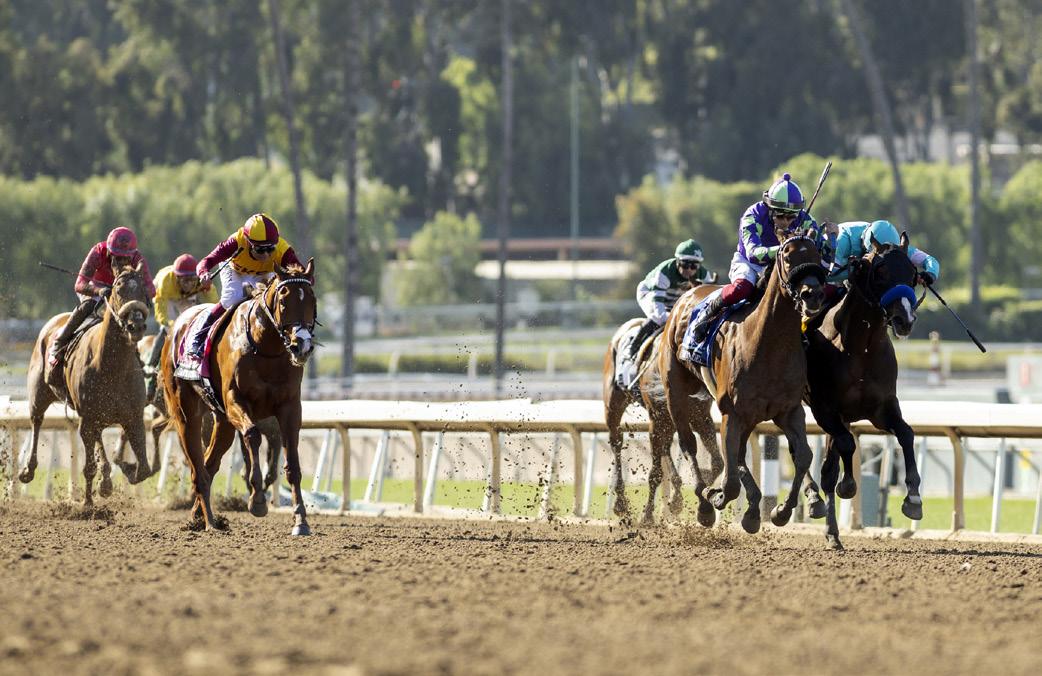
“Spectator died giving birth to her foal,” Waller said. “A punctured colon. I was just sick. There are just so many lows in this business. There’s nothing lower than losing a horse.”
But the foal who survived was Stronghold. “Stronghold grew up on a nurse mare, just as his mother did,” Waller said.
“The people at Mulholland (Mulholland Springs Farm, where Stronghold spent his early days) told me this horse was a man among boys, a very classy looking individual that shows a lot of quality,” Waller said. “I took that seriously because these people are commercial breeders. They see hundreds of yearlings.”
In April of his two-year-old second, Stronghold was sent to California-based trainer Phil D’Amato, who had a string of horses in Kentucky. “Stronghold cast himself in the stall,” Waller said. “We wound up missing several weeks of training. Then, finally, things returned to normal.”
Stronghold finished second and first in a pair of maiden races at Ellis Park and Churchill Downs, then finished second in the
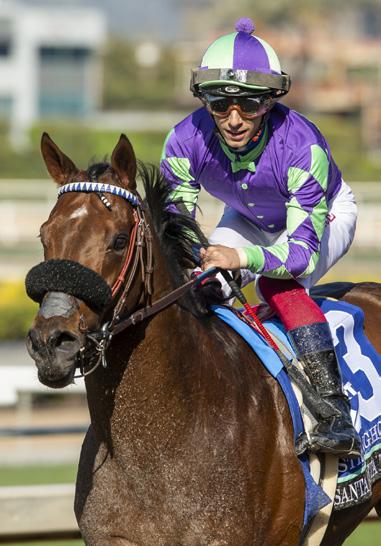
Grade 2 Bob Hope Stakes to undefeated Nysos at Del Mar. He was second again by a half-length to Wynstock in the Grade 2 Los Alamitos Futurity.
Stronghold’s handy victory in his three-year-old debut in the Grade 3 Sunland Derby sent him soaring up the list of Kentucky Derby contenders. His sensational :58 2/5 work should have him moving forward as he tackles tougher opponents.
If all this is exciting, Stronghold doesn’t seem to notice. “He’s so quiet in the paddock, Phil thinks he’s sleeping,” Waller said. “He doesn’t turn a hair.”
Gamely bulling his way through horses, Stronghold won the Santa Anita Derby by a neck, giving Waller his ultimate goal, the one he stuck to despite all the heartache. “The Santa Anita Derby was our first Grade 1,” Waller said. “That’s why I’m in the business. It’s not about the money anymore, it’s about the achievement.”
And his determination. Achievement can’t happen if you give up.
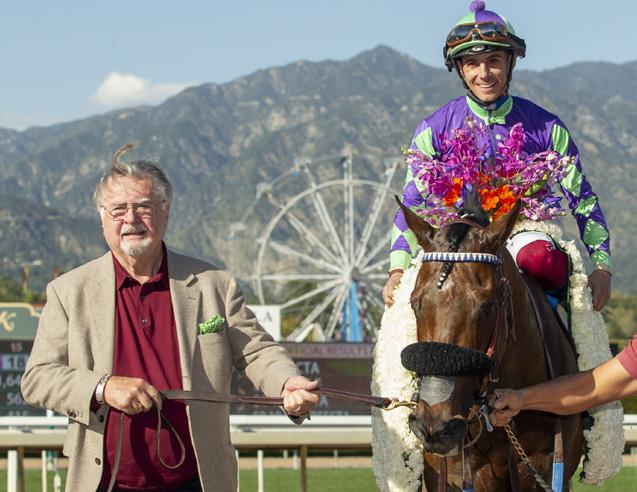




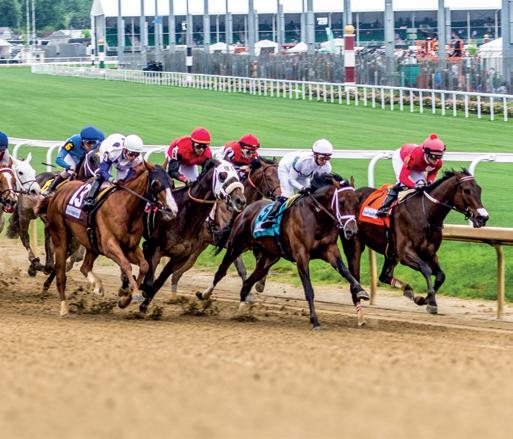

VICTORY
SPORT QUEENS FRONT & HIND
EC QUEENS FRONT & HIND
EC QUEENS FRONT – SOLID HEEL
EC
EC QUEENS WEDGE FRONT & HIND
EC QUEENS 3-DEGREE WEDGE HIND
EC QUEENS FRONT - SOLID HEEL
RX FRONT & HIND
EC QUEENS WEDGE FRONT & HIND
SPORT XLT HIND
EC QUEENS 3-DEGREE WEDGE HIND
SPORT XLT WEDGE HIND

EC XLT HIND
RX FRONT & HIND
EC XLT 3-DEGREE WEDGE HIND
SPORT XLT HIND
SPORT QUEENS FRONT & HIND
RX XLT HIND
SPORT XLT WEDGE HIND
EC QUEENS FRONT - SOLID HEEL
EC XLT HIND ALL SURFACES
EC QUEENS WEDGE FRONT & HIND
EFFECTIVE DATE FOR THE HISA SHOEING RULES AND THE “NON-ENFORCEMENT” GUIDANCE – AUGUST 1, 2022 VISIT HISAUS.ORG FOR UPDATED INFORMATION HISA
EC XLT 3-DEGREE WEDGE HIND VICTORY MODEL DIRT
EC QUEENS 3-DEGREE WEDGE HIND
RX XLT HIND

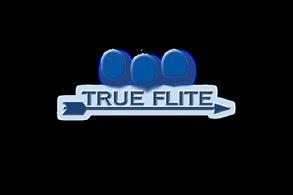




EC QUEENS FRONT & HIND EFFECTIVE DATE FOR THE HISA SHOEING RULES AND THE "NON-ENFORCEMENT" GUIDANCE - AUGUST 1, 2022
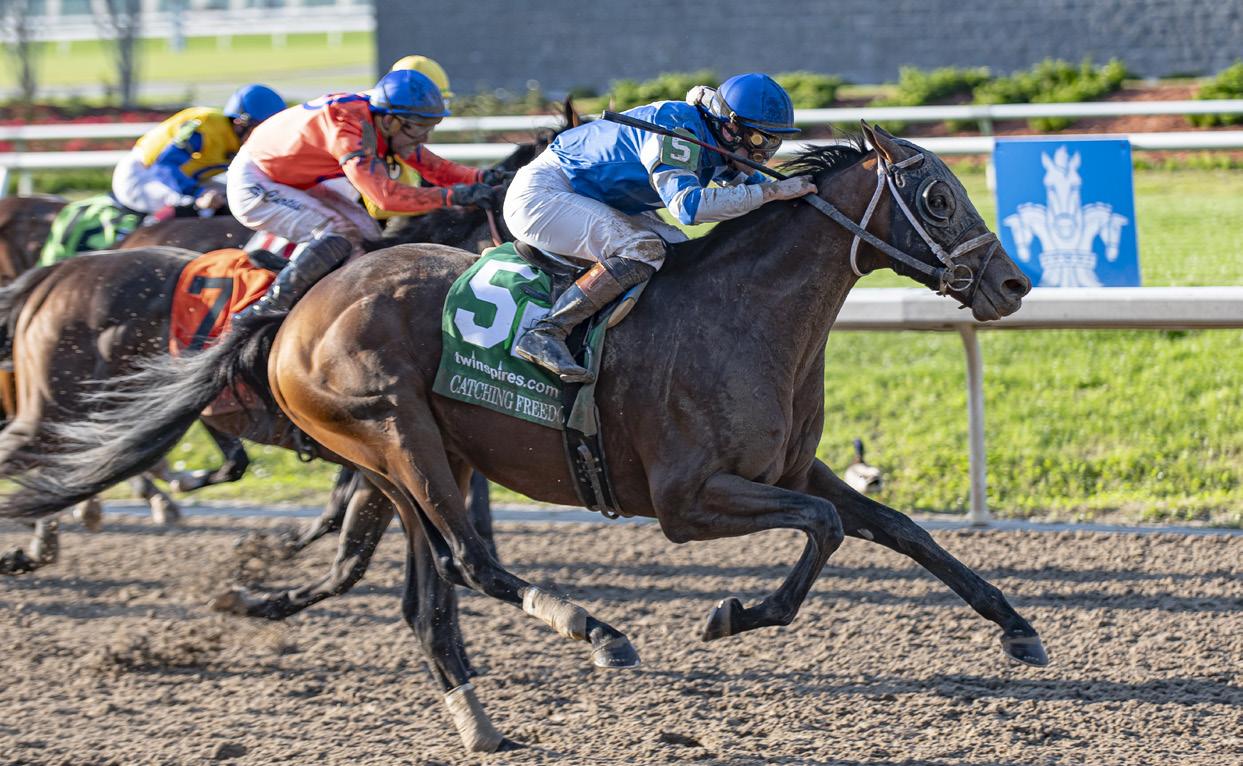
efore he could afford to buy Thoroughbreds, Dennis Albaugh had to succeed in business. And though the start of his one-truck company out of his garage in Ankeny, Iowa, in 1979 was an utter disaster that nearly wiped him out, Albaugh preserved and now owns the ninth largest agricultural chemical company in the world, selling in 44 countries and manufacturing in nine.
BThough he grew up on a farm with a couple of riding horses, he was intrigued with agriculture: “I was always intrigued that you can spray crops with chemicals to protect them.” After two-years of college, he worked for a chemical company for three years. When the company asked him to relocate his family to Birmingham, Alabama, he declined. “I started my own company,” he said.
‘That wasn’t easy. I had to convince my wife to take a second mortgage on the house,” he said. She agreed. “She trusted in me, I guess,” Albaugh said.
The second mortgage allowed Albaugh to receive a $10,000 loan from the Small Business Administration. “It was very tough, I was very new in the business. It was a start-up company.”
He purchased an old oil tanker, bought weed-killing chemicals from a company in Des Moines and delivered them to a company in South Dakota on his very first run. “It was a 200-mile run,” Albaugh said. “On the way up, I thought this truck was running smoother and smoother.”
He reached his destination. “I put the hose in the receiving tank,” he said. “Nothing was coming out. I opened the lid. It was empty. I said, ‘Oh, boy, I just spent $8,000 of my $10,000.’ It was very scary.”
The seals on his truck had failed, and he had dumped his entire load on the trip. “I called the Department of Agriculture and told them I dripped chemicals, but nothing toxic,” Albaugh said. “They said, ‘Thanks for killing all our weeds.’”
Telling the Department of Agriculture was easier than telling his wife what had happened. She asked him, “How did your first delivery go?”
He told her. She didn’t blink.
Undeterred, Albaugh got a couple days’ leeway from his buyer in South Dakota. He quickly bought a new truck and made the same delivery.
And then he grew his company. In 1993, he bought his company’s biggest competitor. “We really soared after that,” he said. “I don’t know the word ‘no.’”
His incredible success in business mirrored his ongoing success with Thoroughbreds, which also had humble beginnings after his son-in-law Jason Loutsch, who is now Albaugh Family Stables Racing Manager, nudged him into
the business. Last year, the stable had three runners in the Kentucky Derby including the favorite, Angel of Empire, who finished a fast-closing third. This year, Catching Freedom has them returning to Louisville on the first Saturday of May.
Loutsch still can’t believe it: “Growing up, my best friend had a horse farm two miles from Prairie Meadows,” Loutsch said. “We made believe we were jockeys.”
Loutsch bought a horse, Mr. Mingo, in 2003, and shared the experience with Albaugh. Mr. Mingo finished second in a $59,000 Iowa-bred stakes in his second start for his new owners. “Dennis said, ‘This is a lot of fun. Let’s get more horses,’” Loutsch said.
They did, buying a half-share of a two-year-old Trippi filly for $42,000 at the Ocala Two-Year-Olds in Training Sale in June, 2005. They named the filly Miss Macy Sue for Albaugh’s granddaughter, and gave her to trainer Kelly Von Hemel.
“She took us all over the country,” says Loutsch, “Then she turned into one of the best broodmares in the country. It really got our juices flowing.”
Albaugh said, “It was unbelievable. We went around the country and she kept doing well.”
Their talented filly won 11 of her 25 starts, including the Grade 3 Winning Colors Stakes at Churchill Downs and five other stakes. She had five seconds and three thirds, including a third in the 2007 Breeders’ Cup Filly & Mare Sprint at Monmouth Park. She earned $880,915.
But she wasn’t done making money. She produced Liam’s Map, who had six wins and two seconds in eight starts, earning $1,358.940, Matera, a four-for-10 winner who earned $309,040 and Taylor S, who went three-for-seven and made $121,518.
Tired of not racing her talented progeny, Albaugh bred her to Giant’s Causeway and named her colt Not This Time. After finishing fifth in his debut, he won a maiden race by 10 lengths, the Grade 3 Iroquois Stakes by 6 ¾ and finished second by a neck to Classic Empire in the 2016 Grade 1 Breeders’ Cup Juvenile.
He’d already made $454,183, but he didn’t race again. He’d hurt a tendon in the Breeders’ Cup race, making his performance even more impressive. Retired to stud, Not This Time finished 2023 as the eighth leading stallion with $13,223,548 in progeny earnings. He stands this year at Taylor Made Stallions for $150,000. “He pays a lot of bills,” Albaugh said.
Along the way, Albaugh and Loutsch began an earnest pursuit of racing’s greatest prize, the Kentucky Derby. In 2016, their Brody’s Cause finished seventh. The next year, J. Boys Echo was 15th. In 2018, Free Drop Billy finished 16th. Dale Romans trained all three horses.
Last year, Angel of Empire, trained by Brad Cox, was third and Cox-trained Jace’s Road, owned in partnership with West Point Thoroughbreds, was 17th. Albaugh Family Stable and Castleton Lyons-owned Cyclone Mischief was 18th.
Catching Freedom, who is trained by Cox, has them dreaming again. “This is the 150th Derby,” Loutsch said. “We know how hard it is. It’s extremely hard to win. There are so many things that have to go right. There are so many factors going into it. This horse definitely wants to go a mile and a quarter. Hopefully, we’re fortunate enough to get a good trip.”
Albaugh said, “Just to get to the Kentucky Derby was a big honor. Having three horses last year was unheard of. We checked the history. We think that’s the record. We’re very thrilled to get back this year.”
Family is an integral part of Albaugh’s life. Loutsch and Albaugh’s daughter Tiffany have two girls, Julianah, 24, and Milan, 18. “They’re in charge of social media,” Loutsch said. “They go to all the races.”
Asked how hard it is to work for his father-in-law, Loutsch said, “Not hard at all. He’s truly one of the best guys in the world. He makes life real easy. No ego. Most importantly, he is fair and honest. He’s invested a lot in the game. We have a lot of fun together.”
Albaugh said, “My son-in-law got my interest going, it’s a whole family. It’s a lot of fun to go with all your family, it’s a lot of fun to get together.”
Especially if it’s in the winner’s circle on the first Saturday in May.


Talk about a tough act to follow. In their first venture together as Thoroughbred owners, Emily Bushnell and Ric Waldman have a Kentucky Derby contender, Resilience, who captured the Grade 2 Wood Memorial at Aqueduct on April 6th by 2 ¼ lengths. Emily’s parents, Marty and Pamela Wygod, bred Resilience, a son of Into Mischief out of Meadowsweet by Smart Strike. “It means everything,” Bushnell said. “The love of the sport, just hoping you have one horse this special. It’s really, really exciting.”
Waldman, a Louisville native, said two days after the Wood, “It’s starting to sink in now. To have an ownership with Emily, a long-time client and friend, it is very emotional. It’s the first racehorse I’ve owned in many years.”
Bushnell was born for this: “I started riding basically before I could walk. My dad had horses when I was growing up. My dad started in the 1960s. He was a hotwalker. He grew up really close to Belmont. It’s been part of my family before I’ve been around.”
Sadly Marty Wygod passed away six days after the Wood victory. Wygod, who was born on February 1st, 1940, in Elmont, New York. He went to high school with Bobby Frankel and was a business administration graduate from New York University. In 1964, he was hired by Roy Nutt and Fletcher Jones for their stock brokerage firm, Computer Sciences Corporation. The following year, Jones, who owned Westerly Stud Farms near Santa Ynez, California, gave Wygod two Thoroughbreds as a 25th birthday gift.
In 1977, Wygod switched careers to the healthcare industry, purchasing Glasrock Medical Services. Five years later, he sold it for a huge profit. He then established Medco Containment Services, Inc., and built it into the largest mail order pharmacy in the country. In 1993, he sold Medco to Merck & Co. for more than $6 billion.
Wygod bought 240-acre River Edge Farm in the Santa Ynez Valley. In 1995, the Wygods moved to Rancho Santa Fe, California.
His slew of top Thoroughbreds includes Exotic Wood, Tranquility Lake, Sweet Caroline, After Market and Life Is Sweet. Wygod is a member of the Jockey Club, a trustee of the Thoroughbred Owners and Breeders Association and a member of the Del Mar Board of Directors. Wygod oversees two Breeders’ Cup Charities, the Rose Foundation and the WebMD Health Foundation.
Wygod’s River Edge Farm stood top California stallions, including Benchmark, Bertrando and Pirate’s Bounty.
Bushnell carved her own niche in Thoroughbred racing. She is the Executive Director, a Therapeutic riding instructor and a mentor of Endeavor Therapeutic, now in its 10th year in Bedford, in Westchester County, New York. Its programs are for veterans, at-risk youth, incarcerates women and children and adults with disabilities. They serve 125 people a week. “Horses have been so important in my life,” Bushnell said. “I wanted to do something with them to help people. Also, horses need jobs.”
She is making a difference.
“She is a lovely woman,” Waldman said. “The whole family is lovely. I’ve worked for Marty and Pam for more than 25 years.”
Waldman, a native of Louisville, has been around Thoroughbred legends, including Storm Cat, Deputy Minister, The Minstrel and Northern Dancer, most of his life. He began his career at FasigTipton Company in 1973 and advanced to general manager in 1981. He was the business manager at Airdrie Stud from 1981 to 1984. He was consultant and syndicate manager of Overbrook Farm from 1986 through 2009 and the vice president of operations and syndicate manager for Windfields Farm from 1987 through 2008.
In 1994, he established Ric Waldman Thoroughbred Consulting, Inc. When Overbrook and Windfields ceased operations, Waldman focused on two long-term clients, Marty Wygod and Samantha Siegel of JayEmEss Stables. He’s been working with them for more than 25 years.
His association with Overbrook’s William T. Young, led him to manage the immortal stallion Storm Cat. But Storm Cat struggled initially. “I started managing Storm Cat in his third year and we sort of limped through his third and fourth year,” Waldman said in a 2013 Blood-Horse story by Evan Hammonds. Working with a star and owning one are different endeavors. Resilience is the culmination of 18 years of planning, purchasing and breeding. The Wygods purchased Tranquility Lake, a daughter of Rahy out of the multiple graded-stakes placed dam Winter’s Love, for $250,000 at the 1996 Keeneland July Sale of Selected Yearlings. She is a half-brother to 1983 Belmont Stakes winner Caveat. Russell Drake, the late River Edge Farm Manager, selected Tranquility Lake.
All she did was win more than $1.6 million, taking the 1999 Breeders’ Cup Handicap at Hollywood Park and the 2000 Yellow Ribbon Stakes at Santa Anita.
She was bred to Storm Cat five times, and her first foal was After Market, a multiple graded stakes winning turf star. Her second foal was Jalil, who was sold to Godolphin for $9.7 million

and won a Group 2 stakes. Tranquility Lake also produced multiple graded-stakes winner Courageous Cat. Hall of Fame trainer Bill Mott, who trains Resilience, trained Courageous Cat.
After producing seven foals, all male, Tranquility Lake was bred to Smart Strike and foaled her first filly, Meadowsweet, the dam of Resilience.

Through their breedings with Storm Cat, the Wygods got to know Waldman. “All the horses we’ve done together, talking with him and my parents on the breeding, working together for quite a while … owning this colt together and being on this journey, Ric and I are on the same page,” Bushnell said. “This is our first one, our first horse together. It was an opportunity for all of us to work together, have a good time together.”
She never imagined how good their first horse would be. But it took a bit of time.
Resilience finished sixth, second and third before winning a maiden race by 4 ¼ lengths. On a sloppy track in the Grade 2 Risen Star, Resilience contested the pace and held on well for fourth.
Mott decided to add blinkers for Resilience’s next start in the Wood Memorial. He relaxed well behind the pacesetters, then pounced on them, winning impressively and sending Waldman and Bushnell onto the Kentucky Derby for the first time.”

The tools for training horses have changed in the last two decades. This new technological era has compelled the centuries-old practices of preparing equine athletes to move with the times, especially with new regulations adding another dimension to the job.

Stopwatches and notebooks now have digital counterparts in smartphones and tablets, allowing trainers with multiple barns to stay on top of their operations even if they are thousands of miles away.
With a variety of tools available now, what are trainers using as they develop their horses while also meeting the requirements of external agencies? How do they handle the influx of information and make it work for their operations? In this new age, trainers are defining their workflows with the tools that work best for them while wrestling with the added costs of the self-education necessary to incorporate these new technologies and meet the increased regulations of the Horse Racing Integrity and Safety Authority (HISA).
Options abound
The digital age brings high-tech options like smartphones and tablets that free users from their desks. Such tools may have a learning curve but that has not stopped multiple conditioners from integrating them into their routines. “I never thought in a million years that I would see Hall of Fame trainers sitting on their horse texting or that I would see [them] recording videos of their horses working” Ron Moquett, trainer of champion sprinter Whitmore, observed.
Now, trainers have many digital options for managing their horses and their employees. A search for apps and software yields tools like Tlore, a web-based management service developed by former exercise rider and assistant
trainer Tracy Attfield, and apps like Sleip and Equimetre, which collect data for assessing a horse’s performance.
Attfield’s Tlore, which is accessible on a smartphone or a desktop computer, serves as a one-stop shop for everything from accounting to tracking a horse’s workouts and daily care. “We do everything through Tlore. I’ve been on Tlore for a long time,” shared Jena Antonucci, trainer of 2023 Belmont Stakes winner Arcangelo. “[It] organizes everything: herd health, Coggins (an equine blood test), communication with owners, [and] can upload videos, pictures, and updates that owners have access to. So centralizing data, if you wanted to take a picture of a horse when it comes in, see how it’s doing, take a 30-day follow-up or whatever, and be able to assess how they are and whatnot. It’s all in one spot, easily accessible by smartphone or desktop.”
Tools like the Equimetre, developed by French company Arioneo, collect physical performance measurements, and improve on earlier iterations of the technology, allowing users to select what data they want rather than offering multiple readings that trainers have to sort through to find what they need. Both Tom Amoss and Tom Morley are currently testing this tool in their barns to see if the data generated is a benefit to their programs. “[We’re] trying to decide whether or not that system is going to benefit us,” Amoss shared. “The old system, compared to that, is literally using a stopwatch and observing with your eyes how the horse is going. So this gives us a little bit more accurate reading in terms of times, specifically when horses work out, which is about once a week for us.”


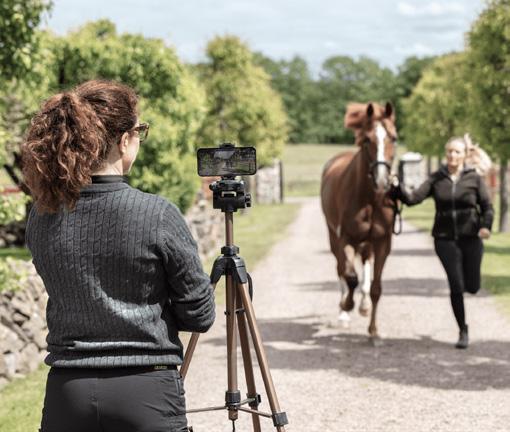

Alongside the Equimetre is Sleip, a Swedish app that uses artificial intelligence to analyze a horse’s gait and help trainers to pick up on even the slightest variation to get ahead of potential issues. Casse has been using the app for two years as another layer of care, videoing his horses daily as part of his care regimen. “When I was introduced to Sleip, I liked it because I felt like every assistant could have one. And it takes about a minute if you know what you’re doing to video it. We get the results back in less than five minutes, and I can know it can be done in Toronto, and I can have the results in my hand in Ocala within minutes.”
In addition to Attfield’s Tlore, trainers like Moquett, Casse, Morley, and John Shirreffs are using readily available services and apps to maintain the data generated by their horses. Moquett and Casse both report using spreadsheets created on either Numbers, an iPhone app, or Microsoft Excel, the nearly forty-year-old software available for use on everything from a smartphone to a desktop.

“Feed charts, the shoeing charts, the day-to-day set lists are all done on an Excel program. It means that I can be sat in Ocala, and I can put a set list together and just email it off to each division, and then they know what they’re doing.” Morley reported, emphasizing the flexibility and simplicity of that software, something that Casse echoed in talking about his process.
“I did use Tlore for a while, but now we have our own deal. It’s an Excel sheet that I developed over 25 years ago. I can go back and tell you, since a horse arrived, whether it was five years ago or four years ago, what the horse has done every day for those four years,” Casse shared. “We keep track of entries there, who we are going to enter, where we’re going to run, where they’re located through the morning. As every track is done, our assistants then send us [their information]. It tells how every horse trained that day. If it worked, there’ll be the workout time, and then they put what they would like to do tomorrow, and I will then review them all. I review it every day.”
Moquett uses a custom chart that he maintains in the Numbers app for keeping up with his horses’ preparations and care and then Tlore for the financial side of his business. The iPhone app serves as the ideal tool for his barn because “you go in there and you make your own log sheets and then it saves it and shares it with whoever you want to,” he shared. “So, we use that as data keeping, [maintaining] our training charts, our workout deals, our notes. All that is there. And it’s pretty cool because on that we have the people in charge of shipping, the people in charge of billing, the people in charge of payroll, and the people in charge of everything use that to get the information to feed Tlore.”
California-based Shirreffs uses several apps to cover everything from taking notes about daily training to scanning his vet book to logging his employees’ hours. The GoodNotes app, available for Apple products, serves as his training log and a repository for notes and other information. He also uses a journaling app called Day One to keep up with day-to-day conditions and Numbers for maintaining charts. All of his tools are linked and the data saved to the iCloud service. “Then if I’m somewhere, I can just look things up on my iPhone because it goes from device to device, [and then] it all goes to the cloud,” the Derby-winning trainer said.

Morley and Amoss also use handicapping tools like the Daily Racing Form’s Formulator, Ragozin sheets, and Ed Tucker’s ThoroManager to help them evaluate potential competition as well as horses that they are interested in claiming or purchasing. Such programs allow users to access detailed past performances, take notes about a potential claim’s performances and evaluate pedigree information, including how well a horse’s family ran at a particular distance or on a specific surface or racetrack.
With all of this data available to these trainers from their chosen tools, is it possible to have too much data? Each has developed systems that work for their operations, which allows them to cut out unnecessary information and focus on what is most useful. Arioneo’s Equimetre and Attfield’s Tlore are ready-made products specifically geared toward the equine industry with not only multiple options for use, but also adaptability that prevents data overload. Apps and software like Numbers, Excel, and other readily available tools allow even more flexibility, giving conditioners the ability to streamline their processes and focus on the most valuable information for their horses’ development and care.
“If you try ten new things, and only one of them is worth it, it’s worth the nine failures. In the past, I have used a few different things that I thought just was too much and too time consuming,” Casse said. “We only have so much time, and you always have to decide, do the assets outweigh the liabilities? Do I get enough out of this to take my time up? And if the answer is not yes, then I move on. And I have used other things, and I’ve moved on.”
As digital tools evolve and their usability is more easily tailored to each trainer’s needs, they become essential parts of the daily workflow, especially now that HISA requires conditioners to register themselves, their employees, and their horses, and maintain records of treatments, medical procedures, and more.

Since July 2022, the Horse Racing Integrity and Safety Authority has required trainers to maintain records about their horses in an online portal. For some, adding the portal to their lists of tasks was another use for the data they were already collecting. “We already had it, so now we’re giving it to them,” Moquett shared. “So, it was a priority for us to make sure we were staying legal, to write down what we were doing, and now it’s priority to keep it, to make sure we’re staying compliant with the rules that they have set.”
What digital tools like Tlore do goes beyond bookkeeping and the care and feeding of horses: they help trainers track the data HISA requires documented. “You just have to play by the rules and input what you’re supposed to be inputting and keep track of your horse’s medical records,” Antonucci shared. “If it gets ace (acepromazine), it goes in. Like checking joints, it gets put in. So that’s just very basic. Whatever the veterinarian does, anytime they touch a horse at a racetrack gets put in.”
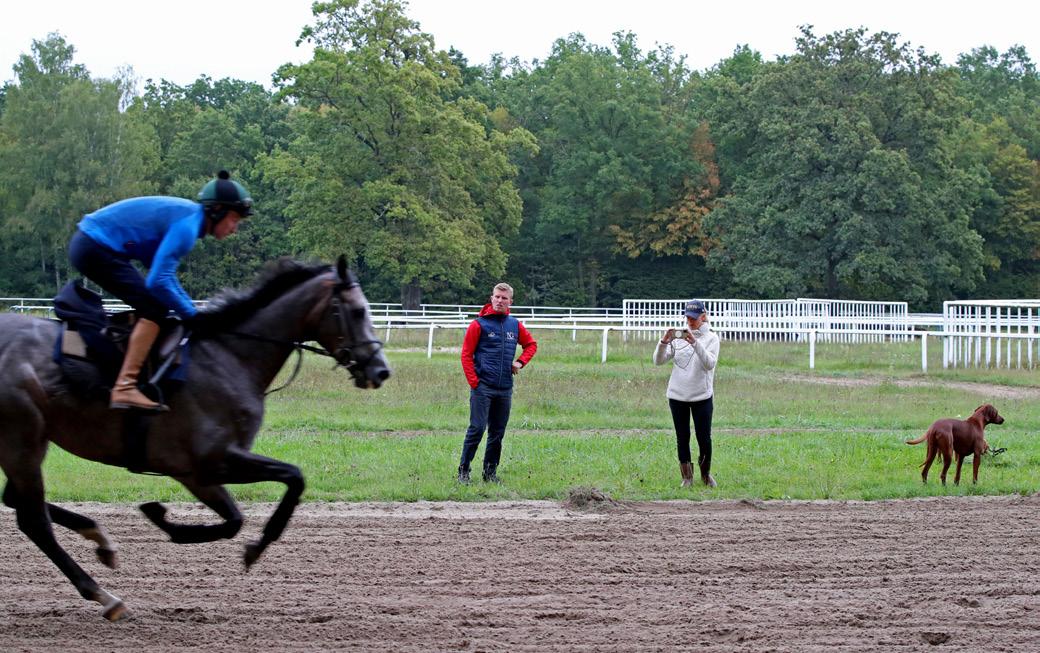
“Every little thing we do now, we record. Definitely, that’s what HISA was there for,” Casse said. “HISA is saying, look, we need to let everybody know when a horse changes hands, what’s been done previously, and that’s important. It’s a pain, but in the end, it’s going to save horses’ lives, and that’s what we’re all trying to achieve.”
The portal gives claiming trainers data they did not previously have. “Now, if you claim a horse, you are privy to their medical records for the past 60 days,” Morley shared. “So, you can not only see when they were vaccinated and wormed, et cetera, et cetera, but also if they’ve had intra-articular injections, if they’ve had a period of colic or sickness, et cetera, over the last 60 days.” This enables trainers to understand what the previous barn had been doing with the horse as they integrate the new trainee into their program.
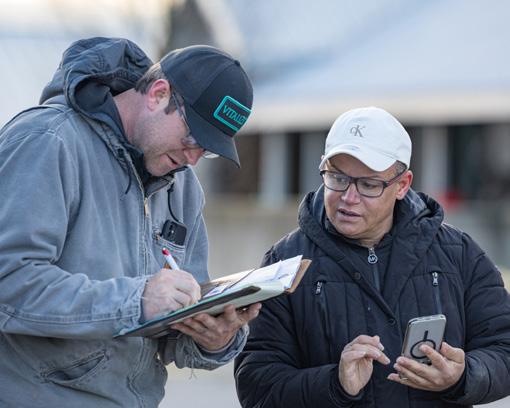

Even though the portal does add another task to trainers’ to-do lists, it does have value, as Morley pointed out: “That’s actually a very good portal for keeping track of records. So rather than us having to flick back through our veterinary records as to when they were last vaccinated, et cetera, it’s all logged in HISA anyway.”
Still, while this new requirement does have its upsides, the portal and the work needed to maintain the required data has become yet another task on a trainer’s long to-do list.
But this kind of digital diligence has its disadvantages. In addition to keeping up with their horses’ day-to-day management, both on the track and off, trainers must document all medical and therapeutic treatments and log that data into HISA’s portal in order to stay compliant. This is especially important for horses coming off a long layup at an off-site facility. Tools like Tlore and other digital workflows might help conditioners maintain this needed information, but those tasks also use two valuable resources: time and money.
John Shirreffs points out the simplicity of the training process prior to HISA and its requirements. “I think that we all feel like we’re being second-guessed, though. We have to substantiate our decision. Before these new tools, I didn’t have to keep up with anything. All I had to do was mark the trainer card, and that would be written in the vet book, and that was it. I didn’t really need to have all this.”
“I think they all detract from the ability to train because I think it takes time. And that’s taking time to enter all this stuff where I could be walking down the shed row and observing a horse or talking to a groom about a horse or something like that,” he shared. “Because I need to keep records, it takes away from the time available, because, by 11:00, you want to wrap things up, so the horses have a chance to rest. You don’t want to be standing in front of the stall staring at them when they want to take a nap.”
Amoss, who worked for Jack Van Berg and Frank Brothers before going out on his own, remembered that “they did all their bookwork and all their recording by hand. There is an advantage to that, in my opinion. And the advantage is that you can, on a daily basis, open that book and review your horse.” The Kentucky Oaks-winning trainer prefers that because “it tends to refresh my thinking on those horses as opposed to turning on my iPad.”
The key for any trainer as they focus on developing their horses is to find workflows that balance the necessities of HISA with the methods that have brought each success. In this transitional moment, these digital tools afford conditioners opportunities to find what works for them as they adapt to these new requirements.
Tools like Equimetre and Sleip are on the cutting edge of digital tools available now, using artificial intelligence and other advances to help trainers keep an eye on their horses’ physical conditions and detect any subtle changes that might evolve into an issue. Along with HISA’s regulations, these provide another layer of preventative care for the animals at the heart of the sport. These advances push racing forward and necessitate adapting to the times, taking old-school practices into the digital age.
“Here’s the thing with old school. I am old school in my mindset of horsemanship, and I’m old school as an approach to getting the horse trained,” Moquett observed. “But saying that I’m old school as an excuse not to get with the times of what’s needed for this kind of stuff, it’s like saying, no, we’re going to haul our horses on a train instead of flying them. We have to [adapt]. That’s what’s required.”
Along with these tools, Casse suggests another advancement that could help trainers: “I’m hoping that somewhere in the future that we’ll have some type of report card that goes with every horse, a passport that tells everything about any type of treatment that the horse has had through his, whether it’s corrective surgery, any type of operation, or anything.”
“We’re still not quite there yet, but that would be something that I hope that our industry can start doing a little better. We need to understand there’s a lot of things that go on, and we need to have more data to see how meaningful it is,” the Hall of Famer concluded.
As this historic sport continues to adapt, as the available apps and software expands, the focus remains on finding the right tools to collect and utilize the information trainers need as they balance their official duties with their focus on developing their horses for the racetrack and beyond.
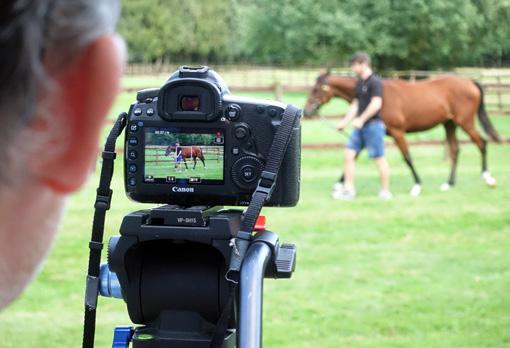

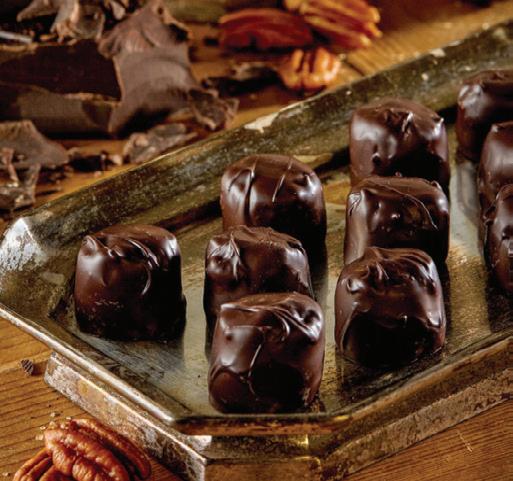


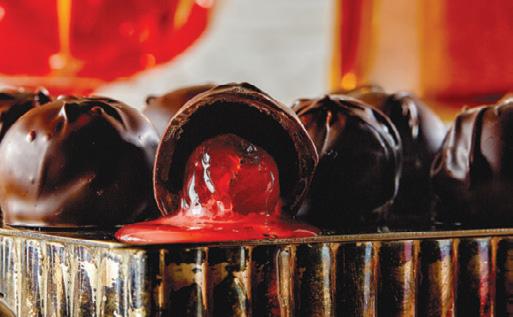
The 2024 Jockey Club Fact Book showed that the average field size run in 2023 races was 7.40, down from 7.59. Thoroughbreds’ average number of starts also dipped from 6.01 to 5.87. Back in 1990, the average field size was 8.91 and the average number of starts 7.94. Why are the average number of starts and field size declining annually?

# Todd Pletcher
I think the number starts, in a lot of cases, is management. I think over the years trainers have become more conservative about how many starts horses have with more time between races. More rules about when you can train your horses may be a factor. And the foal crop is having an absolute impact.


# Tom Proctor
Wow. You would need more than a sound bite. I’d be forever telling you why. I don’t have a say in how this business goes. There are people who win a zillion races and their opinions don’t matter.

# Dale Romans
That’s a good question. It’s above my pay grade. I’d say the reduction in foals every year. Also, it’s a lot more difficult to run a horse. More horses are scratched by veterinarians.

# Brian Lynch
Is it the foal crop? That would be my answer to that. There’s always concern that the tracks haven’t been the best. There have been more breakdowns than I’ve ever seen. More to the point, it’s the foal crop.






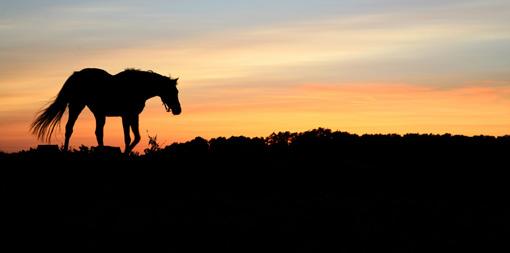

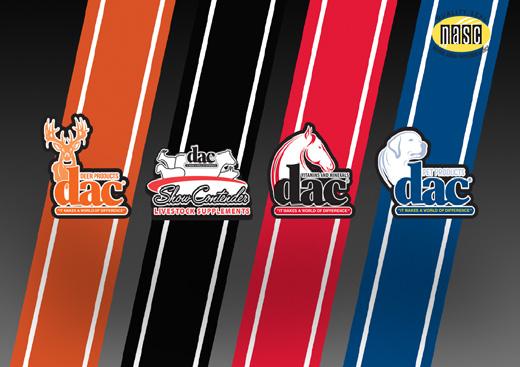


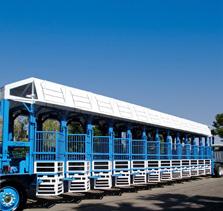



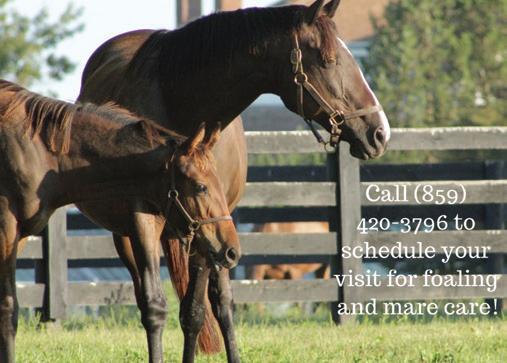


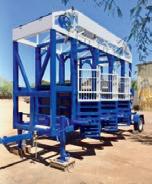

It’s very simple. The foal crop has been down for a long time. It should be 40,000 (In 1990, it was 40,333; last year an estimated 17,200). Obviously, it’s going to catch up with us. Also, you’ve got the new ruling body. It’s a different game these days. You have people coming up that don’t know how to take care of horses.



I think it’s pretty simple. I run over a thousand starts a year. I have to enter over 3,500 times to do that. I would have 50 percent more starts if there were races for me. That tells you. I’m lucky because we have options. I can look at different tracks. But I can have 15 horses in my barn with no races for them.
When I first started, they didn’t publish every trainer’s statistics. They’re all worried about their percentages. Their horses stay in the barn.
The other thing, in my opinion, the state programs have really hurt, and I’ll tell you why. Fifteen, maybe 20 years ago, I went to California, I never got a long maiden long race. The Cal-bred horses did. That’s another factor.

The horses just aren’t as hardy as they used to be. Justify, he ran six times and he’s one of the leading sires in the country. And he didn’t start until his three-year-old season. You can’t do basic therapy anymore. These horses are athletes and you need to take care of them. You’ve got to be able to train your horses. They make it really hard. You can’t pinfire your horses’ shins. You can’t blister a horse any more. Horses don’t even feel that. It’s about the calmest thing you can do. They’ve got the wrong people making these decisions.

The truth is with HISA coming in and veterinary restrictions, we can’t run the horses as often as we used to. All the restrictions and all the veterinary requirements, including expensive scans we’re under now, are certainly one of the reasons. We have a lot more restrictions.
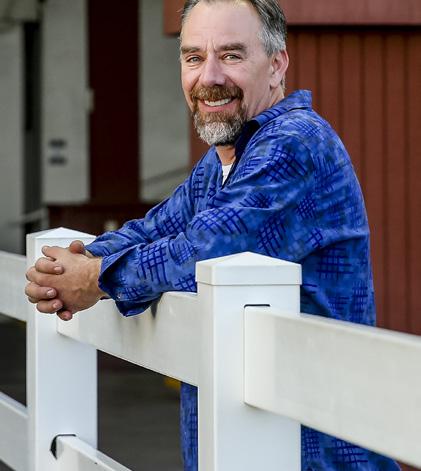
Golly, where do you begin? I was looking at the Fact Book last night, and what I was most concerned with was looking at foal crops by region. I began shaking my head. Every region is down. In the future, there’s only going to be racing in Kentucky and New York. It’s returning to the sport of kings. I think what’s missed, due to the economics, is that people are giving up on horses much quicker. That’s a huge factor. Also, there are fewer opportunities.
SATURDAY JULY 20, 2024
$125,000 Brookmeade Stakes VA BRED OR SIRED, Fillies & Mares, 3 and up, 11⁄16 mi., turf
$125,000 Edward P Evans Stakes VA BRED OR SIRED, 3 and up, 1 mi., turf
$125,000 Punch Line Stakes VA BRED OR SIRED, 3 and up, 5.5 fur., turf
$125,000 Typson Gilpin/Glenn Petty Stakes VA BRED OR SIRED, Fillies & mares, 5.5 fur., turf
SATURDAY, AUGUST 3, 2024
$150,000 Hickory Tree Stakes VA BRED, SIRED, OR CERTIFIED, 2 year olds, 5.5 fur., dirt
$150,000 Keswick Stakes VA BRED, SIRED, OR CERTIFIED, Fillies, 2 year olds, 5.5 fur., dirt
SATURDAY AUGUST 31,2024
$150,000 Bert Allen Handicap VA BRED, SIRED, OR CERTIFIED, 3 and up, 11⁄16 mi., turf
$150,000 Camptown Handicap VA BRED, SIRED, OR CERTIFIED, Fillies & Mares, 3 and up, 5.5 fur., turf
$125,000 Jamestown Stakes VA BRED OR SIRED, 2 year olds, 5.5 fur., turf
$150,000 Meadow Stable Handicap VA BRED, SIRED, OR CERTIFIED, 3 and up, 5.5 fur., turf
$150,000 Nellie Mae Cox Handicap VA BRED, SIRED, OR CERTIFIED, Fillies & Mares, 3 and up, 11⁄16 mi., turf

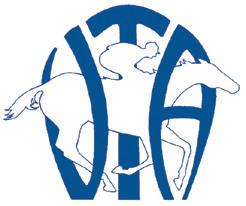
See VaBred.org for program details or contact the Virginia Thoroughbred Association at 434-977-3716
2024 Stud Fee: $125,000 LFSN Good MaGic - The classic sire
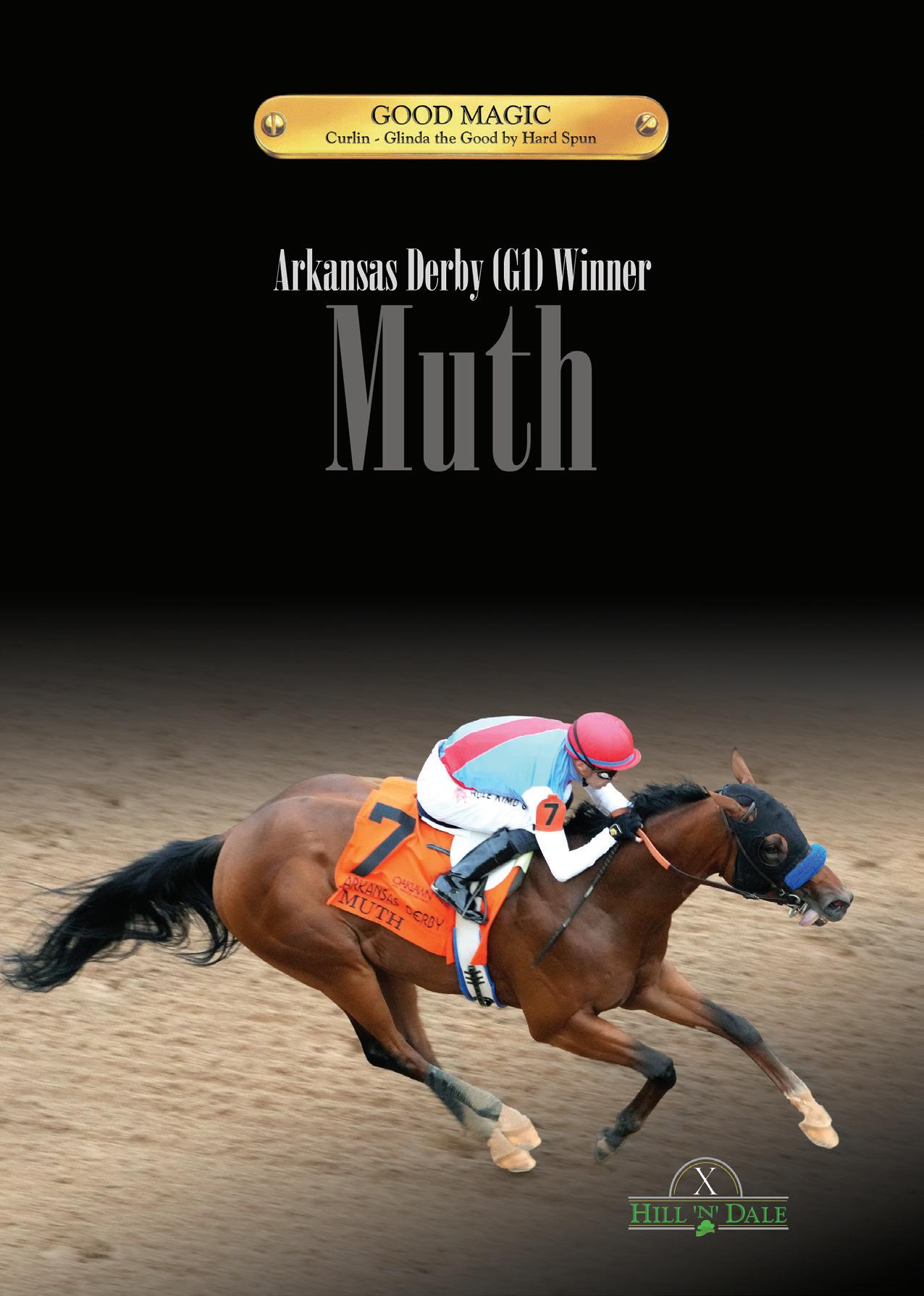
The winner of last year’s Kentucky Derby, MAGE by Good Magic, is a full brother to DORNOCH, one of the Leading Hopefuls for this year’s Derby (G1).
As of press time, MG1SW MUTH, a $2,000,000 2YO purchase, is the #1 Rated 3YO in America per The Thoroughbred Daily News.